The vegetable garden has been dug up, the seedlings are already ready for planting, but in addition to vegetables and useful crops, I would like to draw attention to the beauty of the garden, namely the fence of the flower beds. Flowers growing one by one or in pairs, descending in garlands from the balcony boxes, or arranged in a single composition under the windows of your beloved home, will give joy after working day and allow you to take a break from work. But how can this beauty be preserved? How to protect flowers from the ubiquitous lawn mower fishing line, from children who are always running somewhere, from dogs who try to lie down on them? Consider a few examples of DIY flower bed fences, using available materials and the minimum number of tools.
The stone is not the enemy of plants. Many people know that sculptures made of durable granite, centuries later, have brought to this day the beautiful faces of ancient women and the muscular torsos of men. Frozen in stone, they are still striking in their beauty.
And why not use this durable material to decorate adorable petunias, lupines, cosmes, marigolds. Granite and marble, of course, are not the cheapest option, but you can resort to the help of improvised representatives of the stone world, for example, cobblestones that can be found almost everywhere. Having made a considerable supply, you can impose a large enough one, thereby protecting it from lawn mowers and other cutting tools.
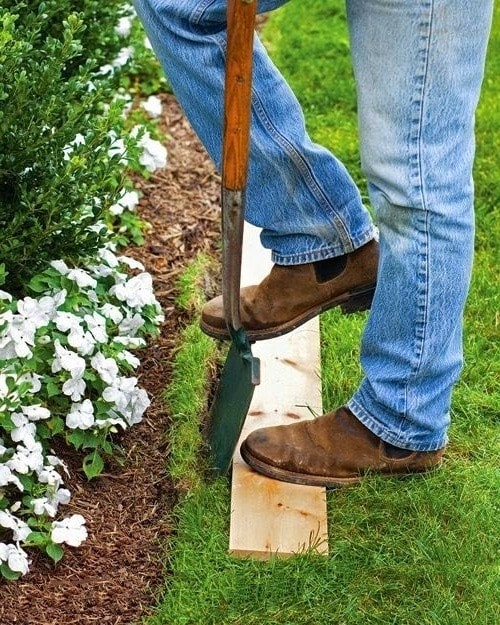
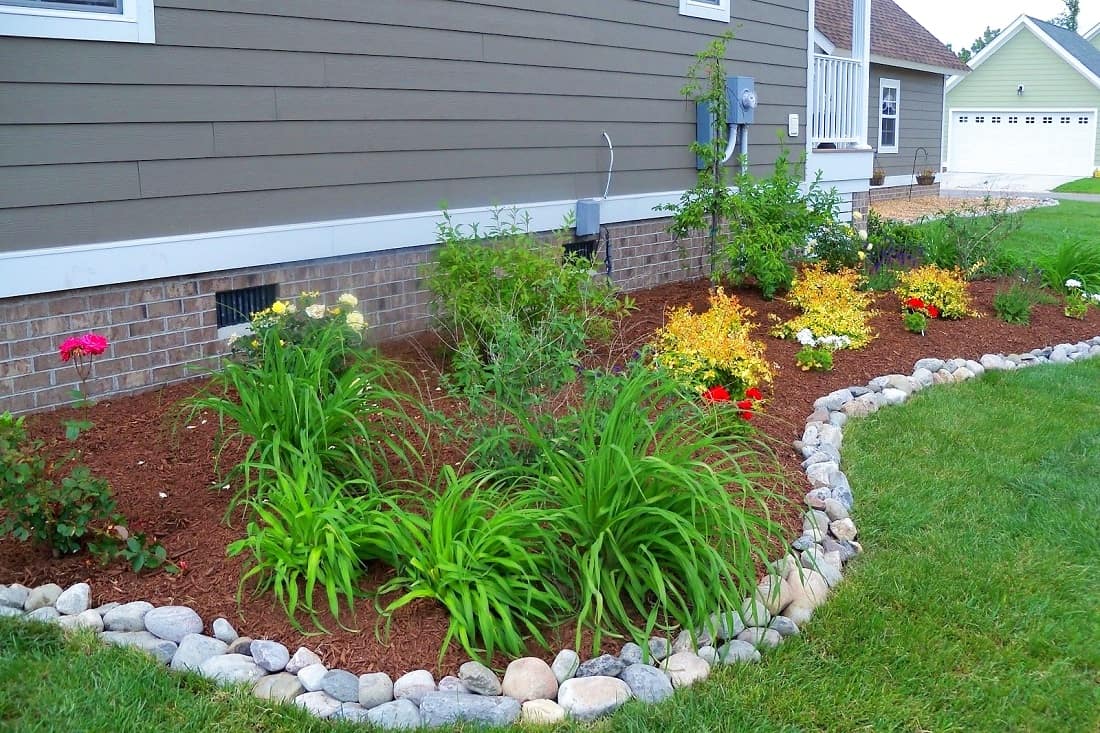
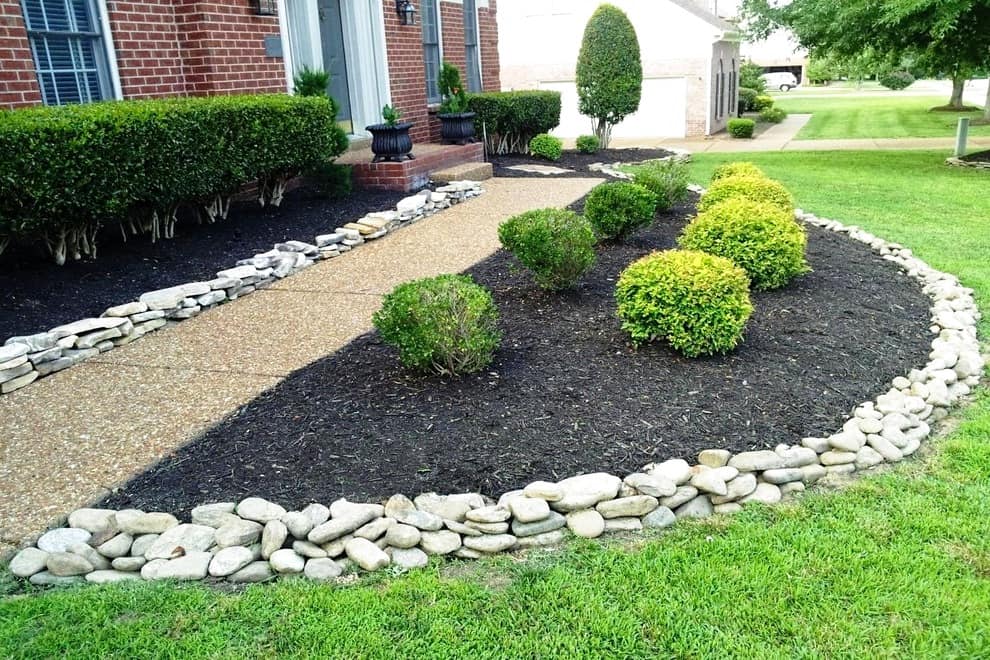
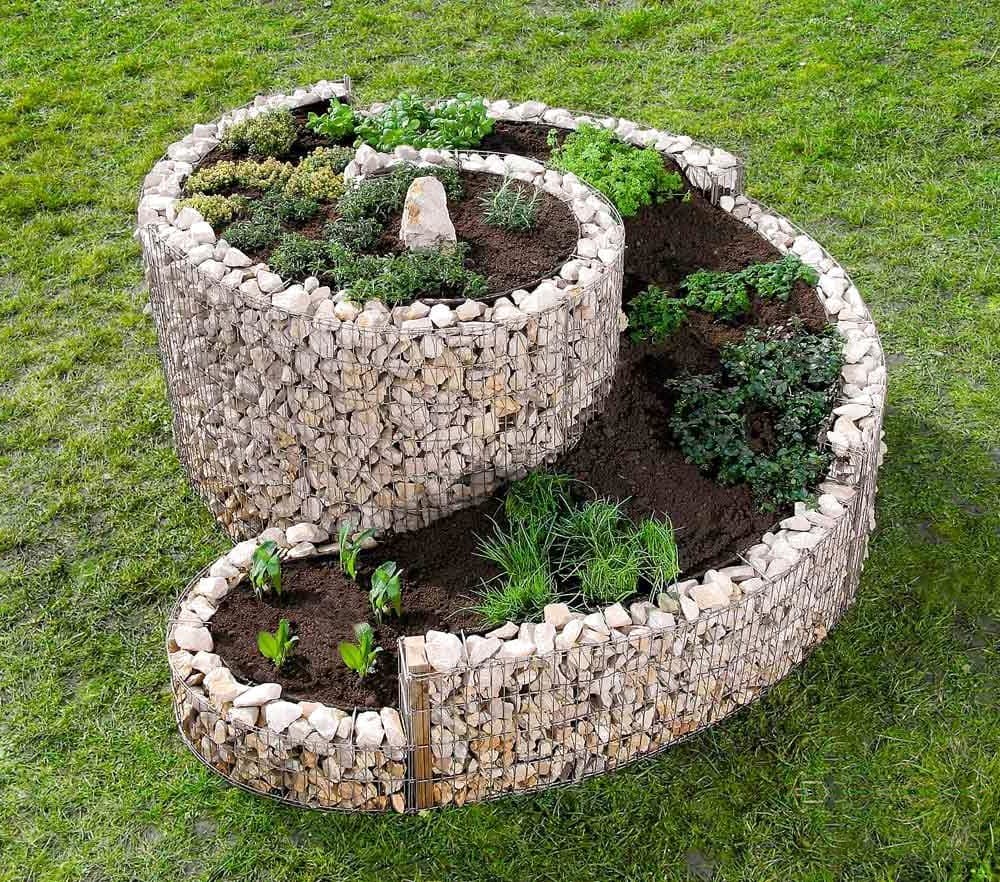
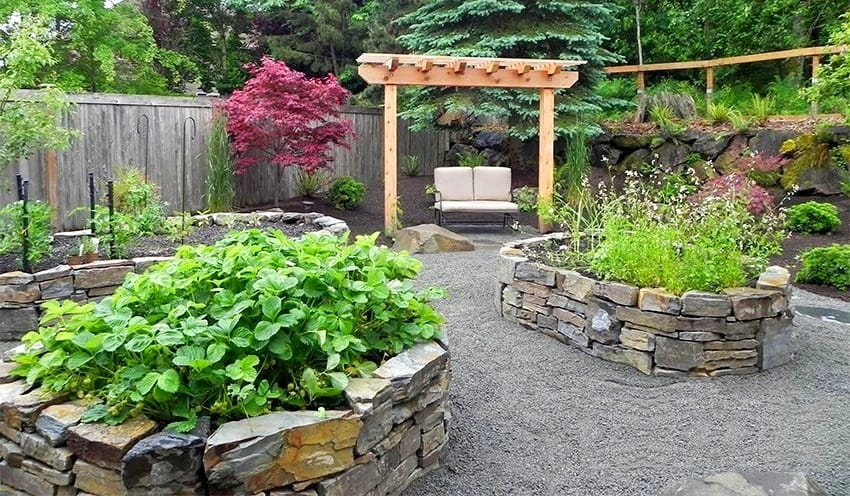
Variants of forms of natural fencing for stone beds depend only on the imagination of the author and the amount of source material. The advantage of this fence is durability, and the disadvantage can be considered a small height and, over time, natural subsidence deep into the soil.
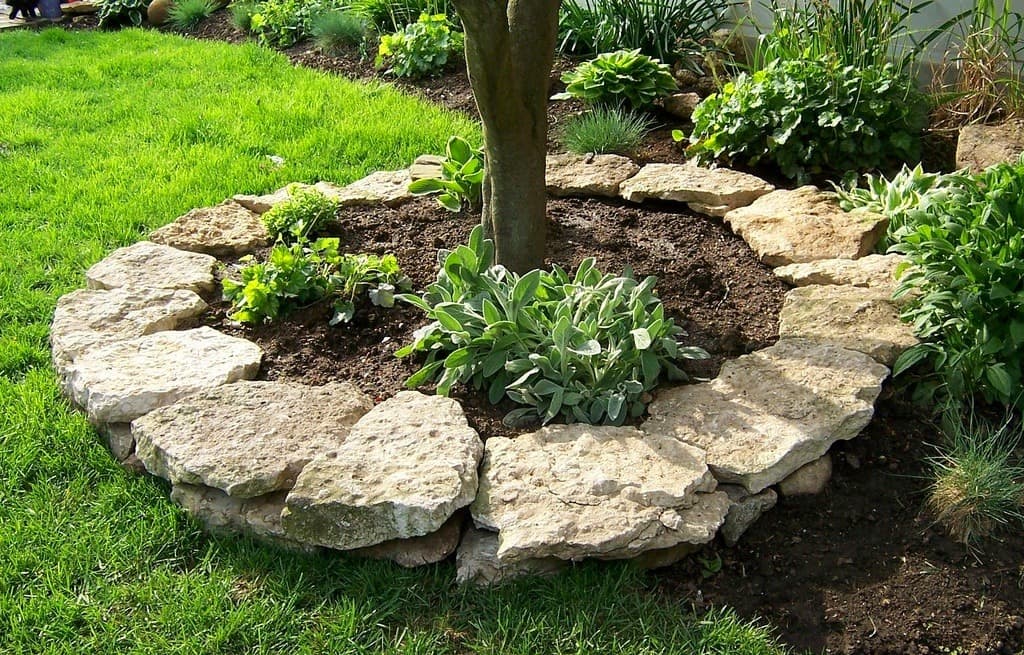
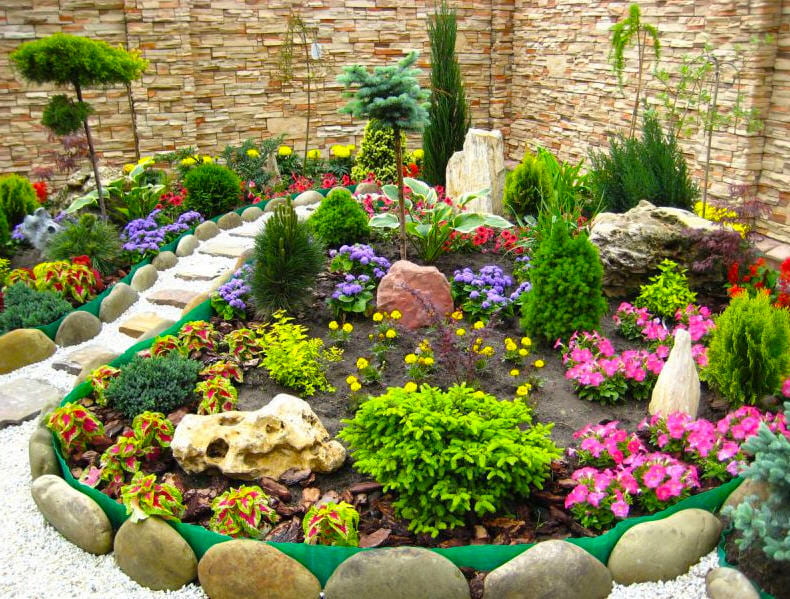
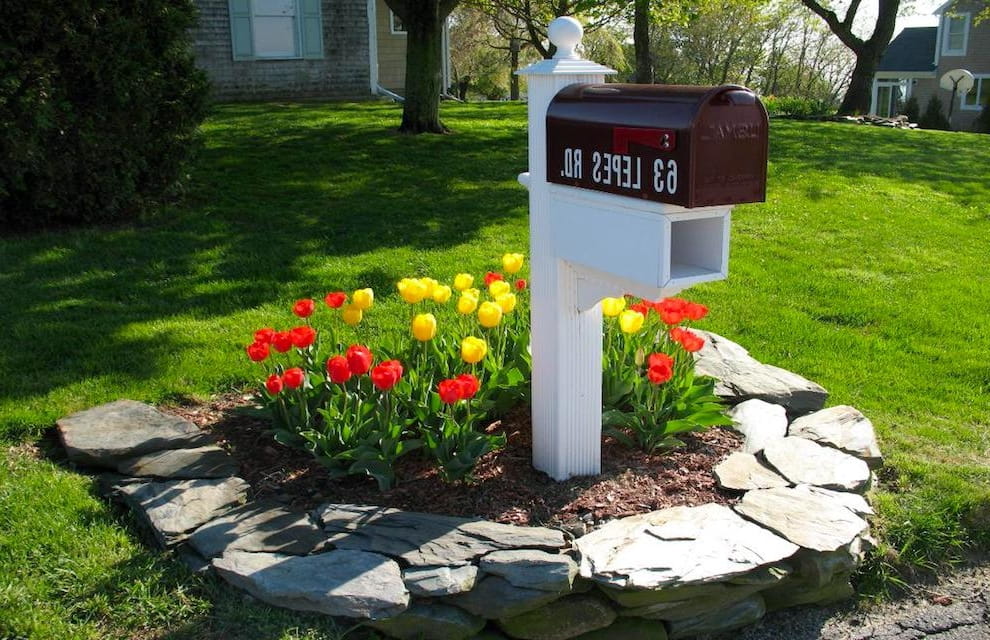
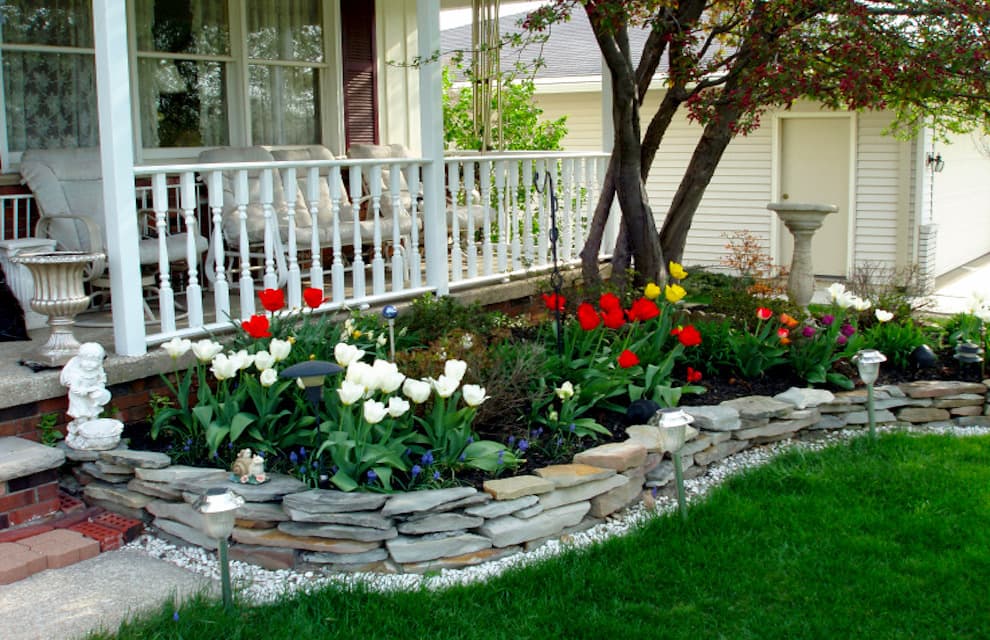
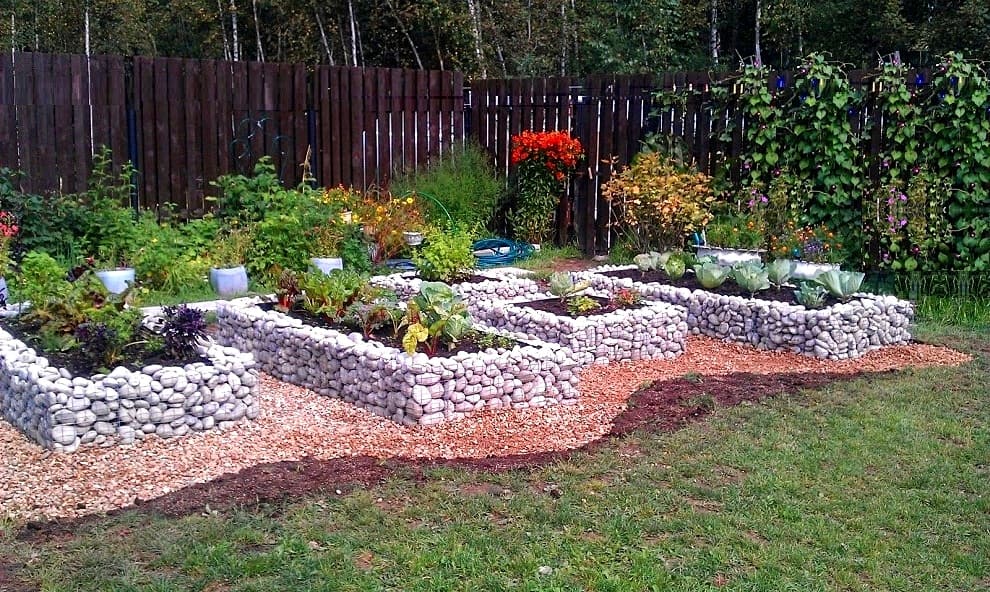
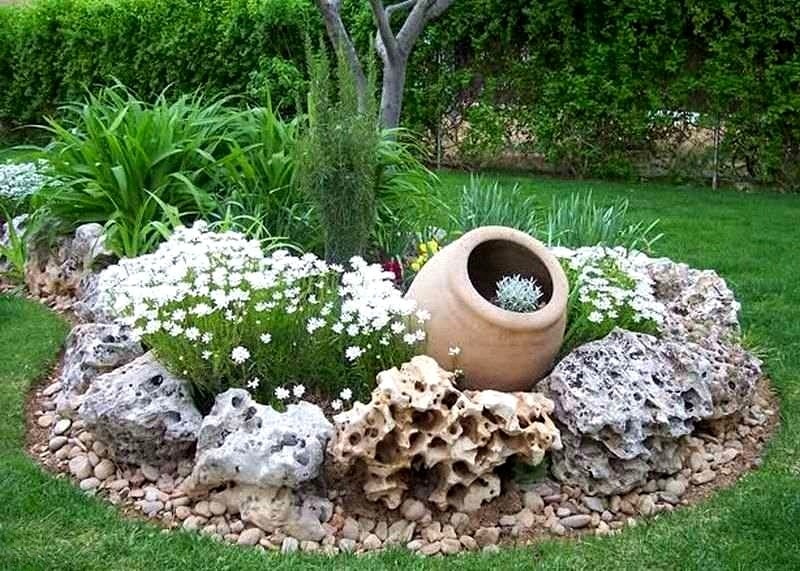
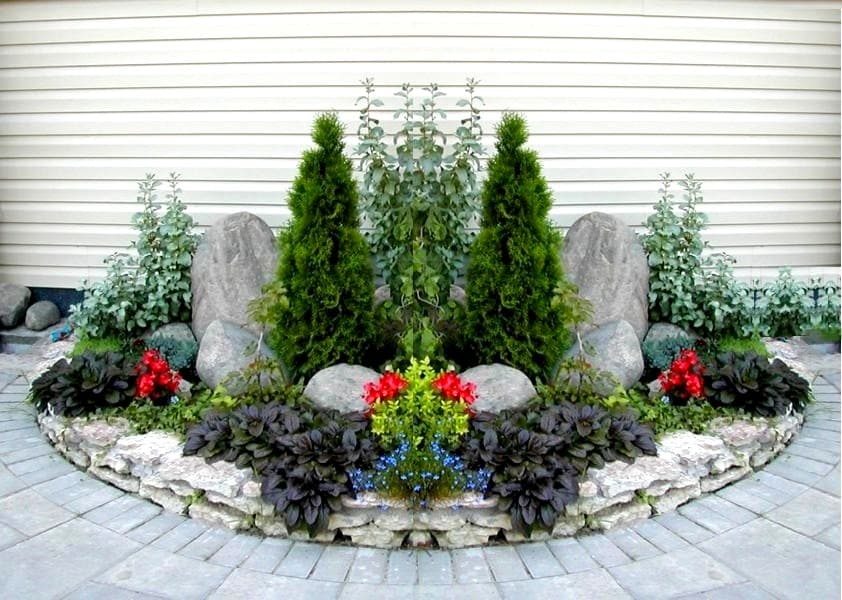
A fence for a flower garden from wooden pegs (photo)
I'm tired of the old skirting board, why throw it away? Miniature, up to 20 centimeters, wooden fences are very unusual and look pleasant, protecting medium-sized plants. The construction of such a fence will take several hours and a couple of three meters of the old plinth.
- First of all, you need to decide on the height, mark it on the base, and saw off the pegs, of which the fence will consist.
- For the convenience of inserting such blanks into the ground, it is advisable to make sharp corner, and leave the top straight.
- The pegs are either dug in or driven into the ground by 5-10 cm, for greater strength. Thus, the workpiece is a peg 30-35 cm long.
The advantage of such a fence for flower beds is its original shape. The disadvantages include the difficulty of setting a straight line, but using a level, you can achieve greater accuracy.
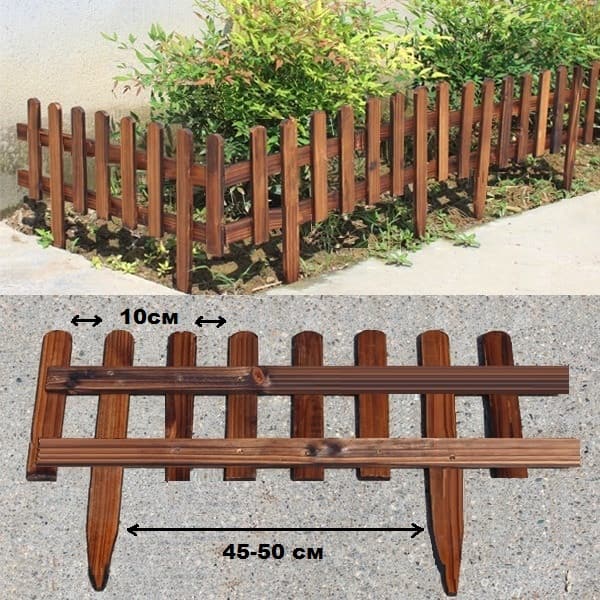
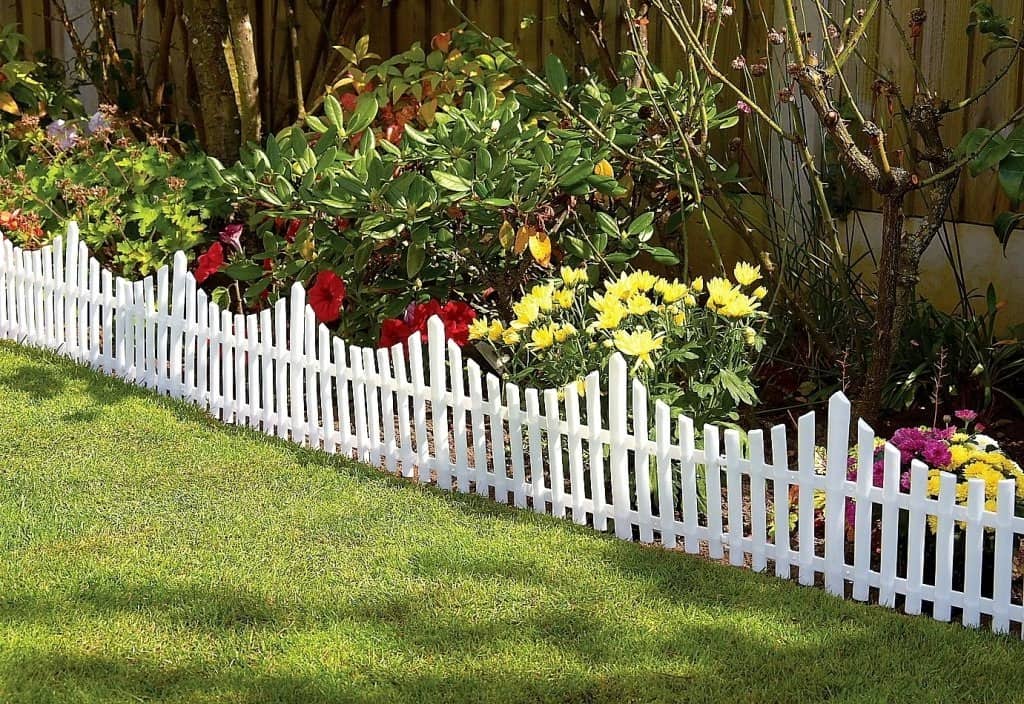
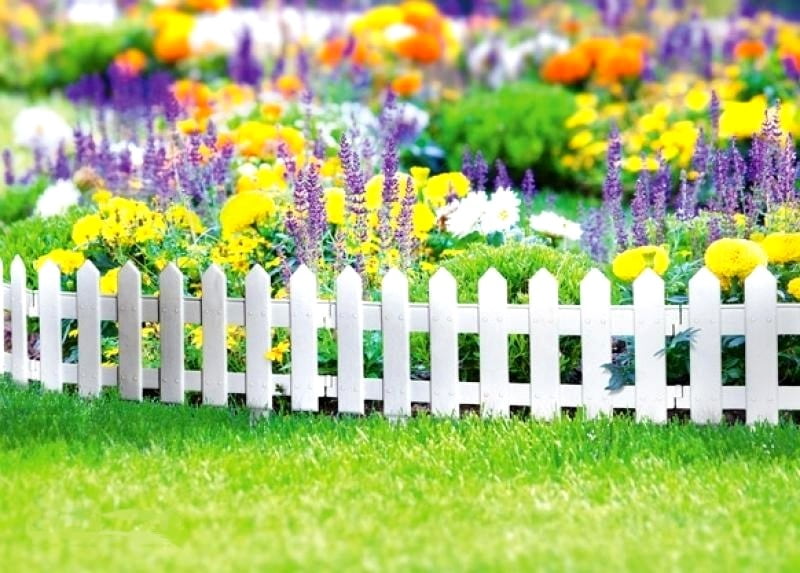
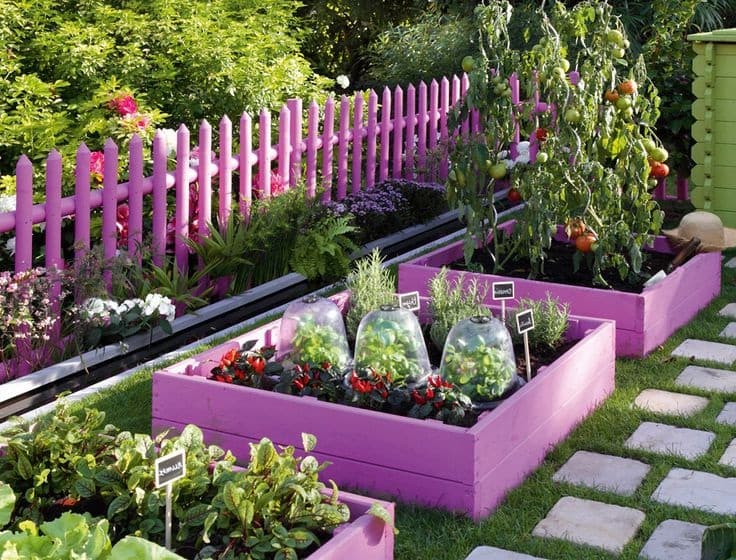
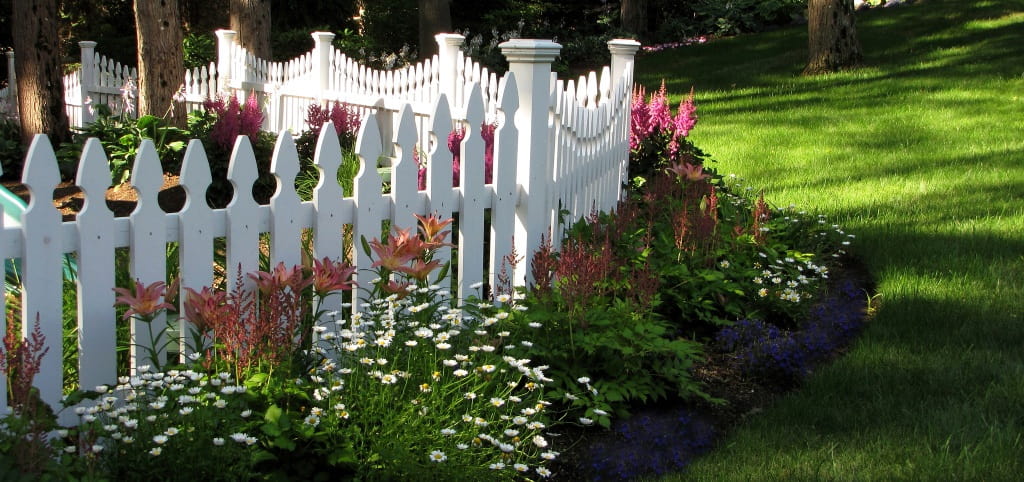

Glass bottle fencing - simple and affordable
Glass is not a new material, and even less expensive. After all, for sure in your house there is sometimes a bottle of beer, champagne, Coca-Cola or lemonade near the trash can. They will serve as an excellent basis for a decorative fence. All you need to do is collect the required number of glass bottles. For a medium-sized flower bed, you will need about 20-30 pcs. During the winter period, it will not be difficult to collect such an amount.
The construction technology is extremely simple, having pulled out a small hole, you need to stick the glass bottle with the neck down and dig it in for greater strength. The usual building level will help to maintain a straight horizontal line. Glass bottle fences - durable, and look great in the neighborhood with low plants.
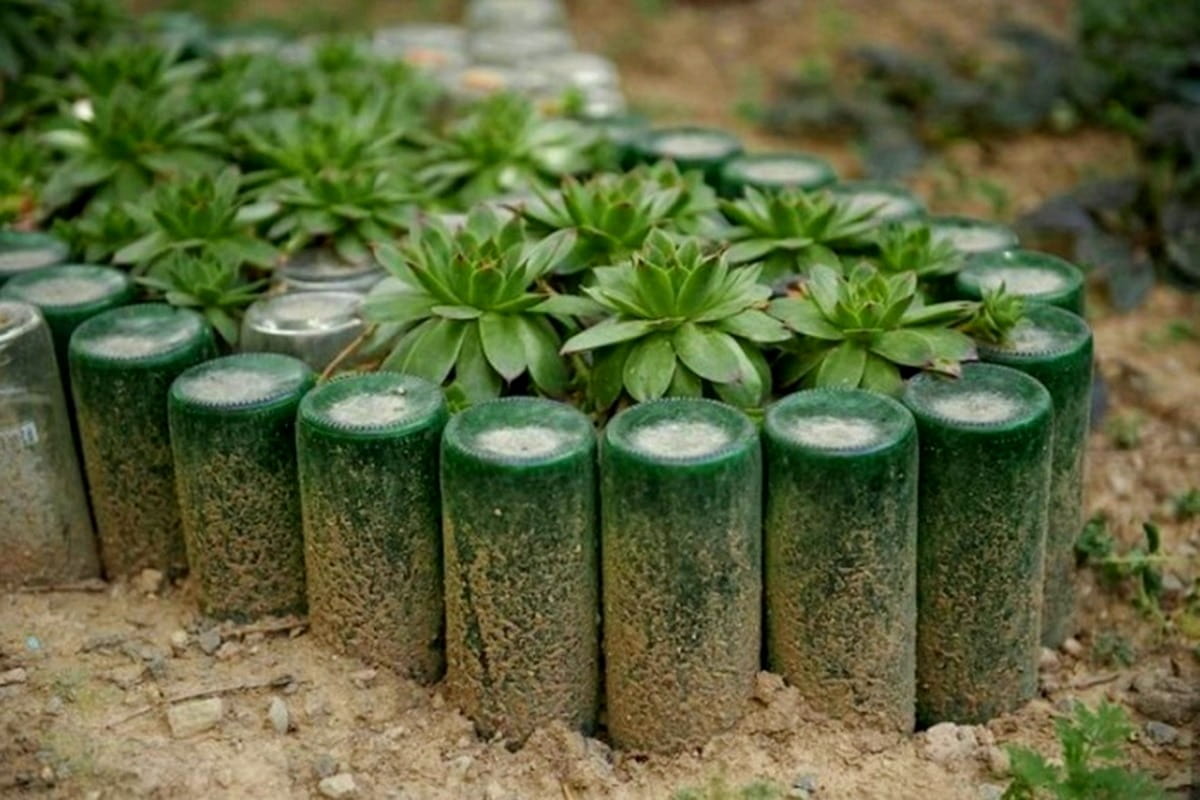

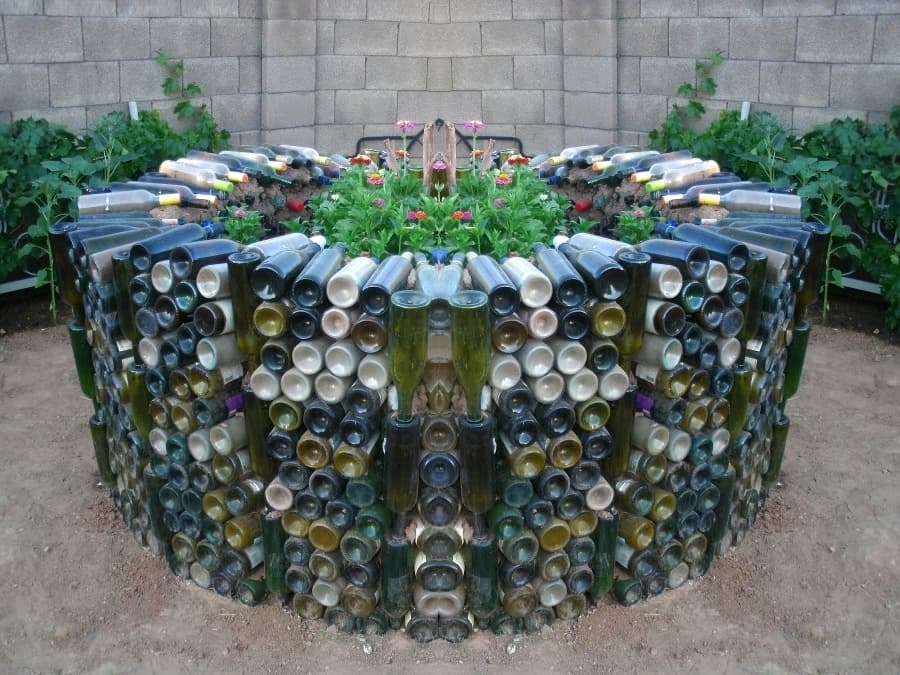
Considering possible ways to improve a flower bed, each owner is looking for the simplest and most affordable option. It is easier than creating a fence with stone chips, wood, or glass bottles. Let's look at a few more design options for floral splendor:
Wooden rods and tree branches as a fence
Twigs and branches - for a fire or for work? It couldn't be easier to build original fences for flower beds from branches of an old tree that has fallen under an ax! Naturally, branches are taken as a basis, but their selection is very important.
To decorate the flower bed, it is advisable to use straight or slightly curved rods. Branches with knots or shoots are not suitable for work, since with the growth of green spaces, the stems will hang and cling to them. Straight branches should preferably be barked and dried. Impregnation of them with antifungal agents is also ideal, but not necessary.
The construction of such a fence is done as follows:
- Straight base stakes are driven into the ground at a distance of 10-15 cm, twigs or branches are laid out between them;
- Fastening, for greater stability, is carried out with a twine or fishing line. The height of the structure depends on the number of rows thus laid.
The advantages of the design are simplicity of execution and naturalness. appearance... The disadvantages include a small durability, in general, from 2 to 3 years, and the possibility of warping under the influence of weather conditions.
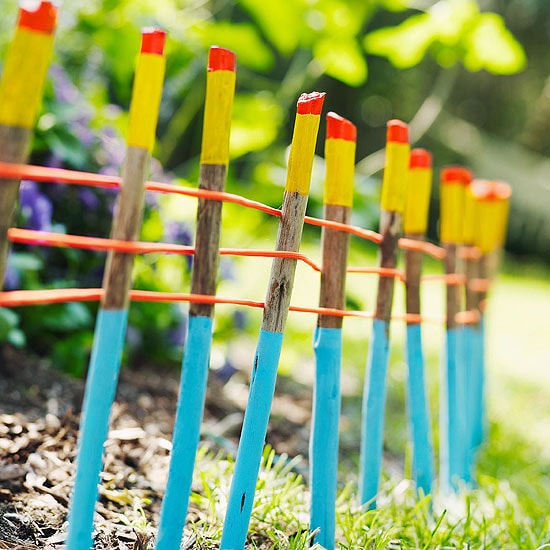
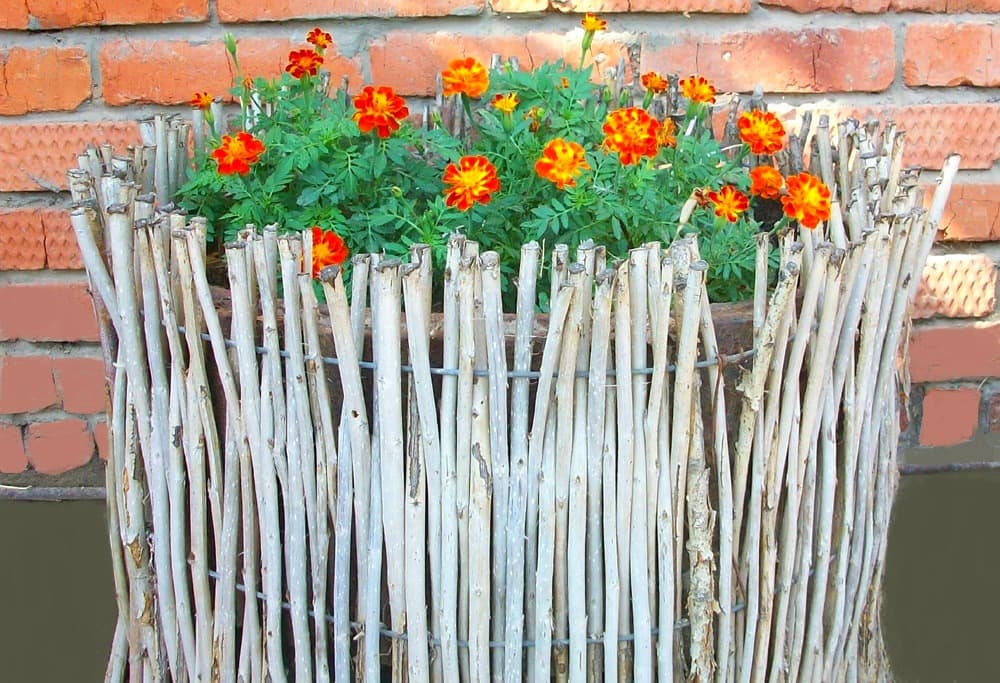
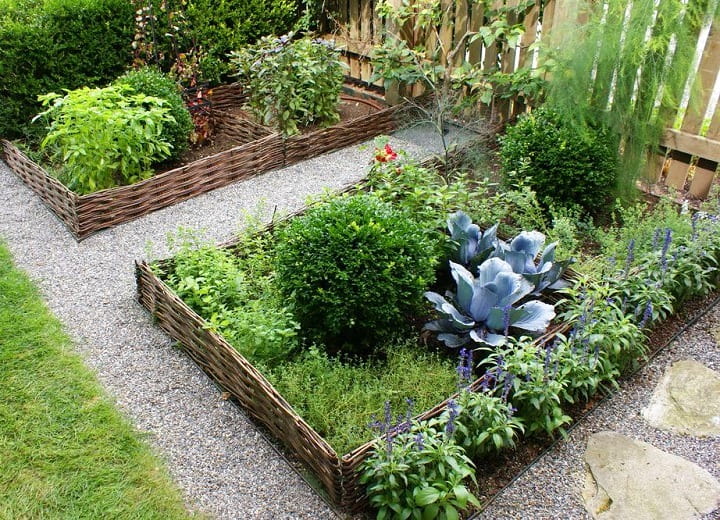
Another option for wicker fences is vines for flower beds. It looks very aesthetically pleasing. The method is similar to the construction of branches and twigs, only due to the length of the main material in the process of laying out the rows, the main peg-supports are intertwined.
The advantages of this version of the improvement of the flower bed are its excellent combination with the landscape and aesthetically simple appeal. The downside is that a short service life and possible corrosion of the material. To correct these shortcomings, wood processing tools will help.
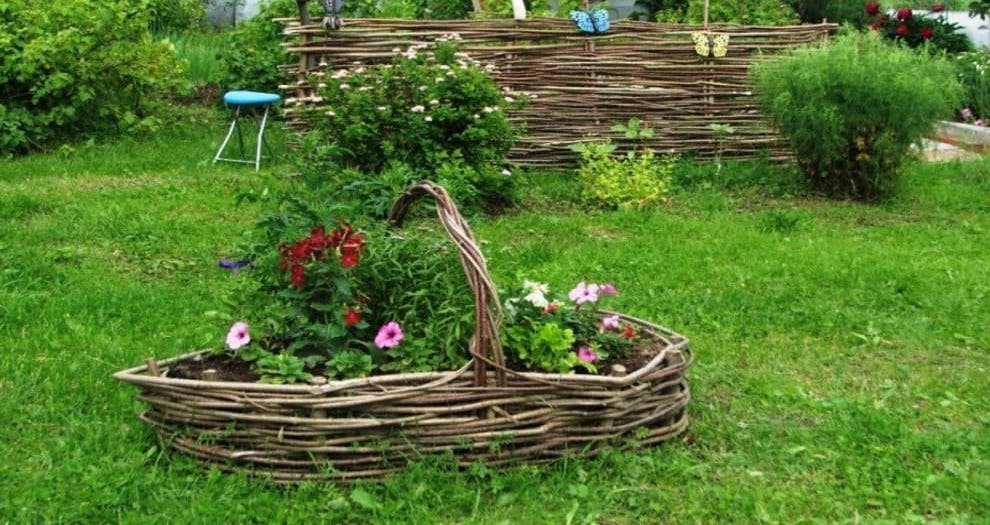
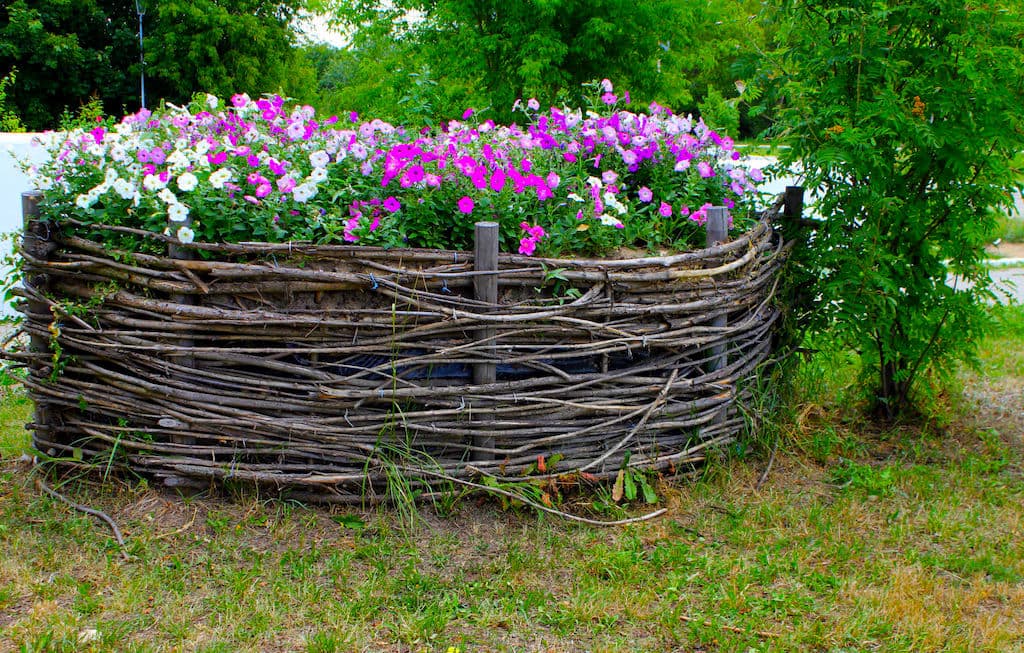
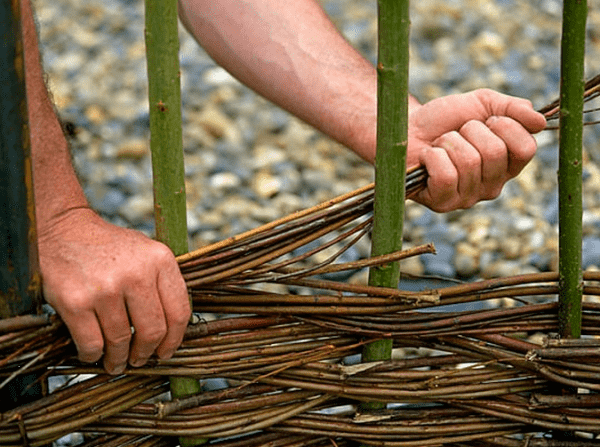
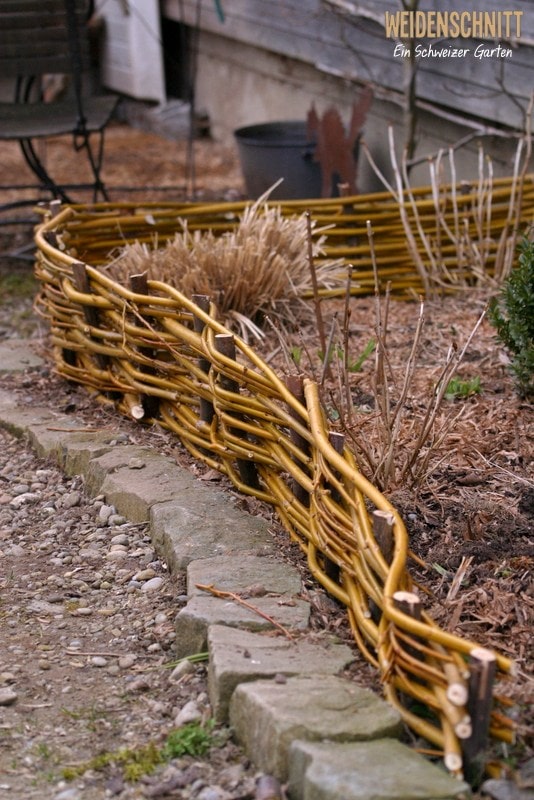
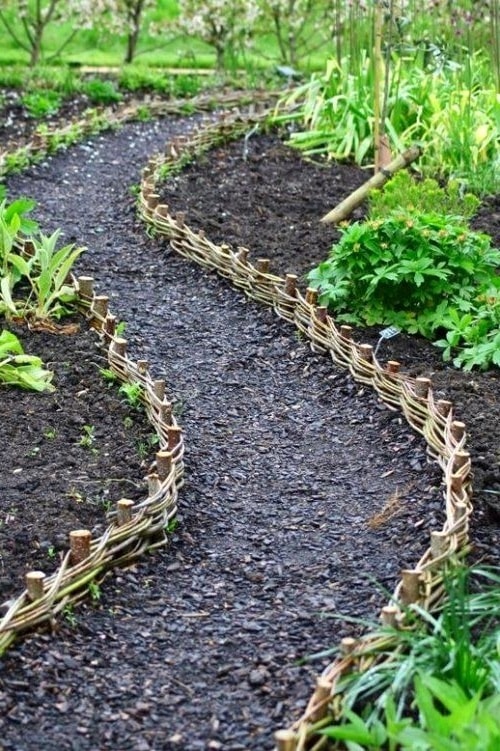
Macrame in garden design (photo)
The macrame technique, which is based on a special interlacing of threads, can be a wonderful and unusual option for decorating a flower bed. Naturally, strong twine will serve as the main material. You can take any drawing. Detailed diagrams can be found on the Internet or in craft magazines.
The original baubles will be fastened with wooden pegs, which can also be braided to match the main motive. The advantage of this work is its originality. The disadvantages include a fairly long operating time and a short service life. 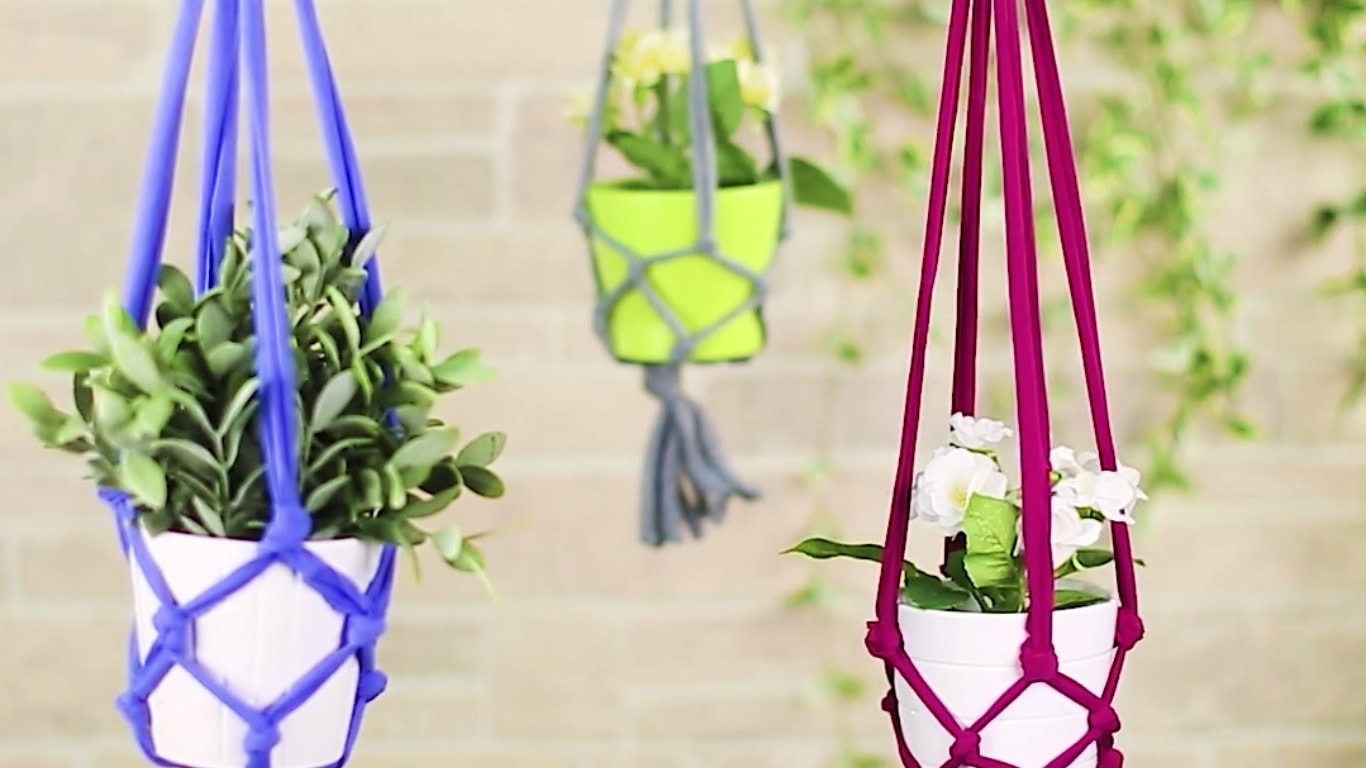
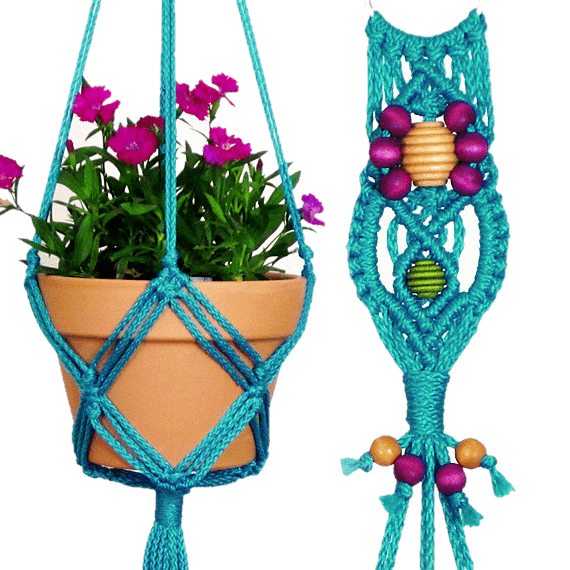
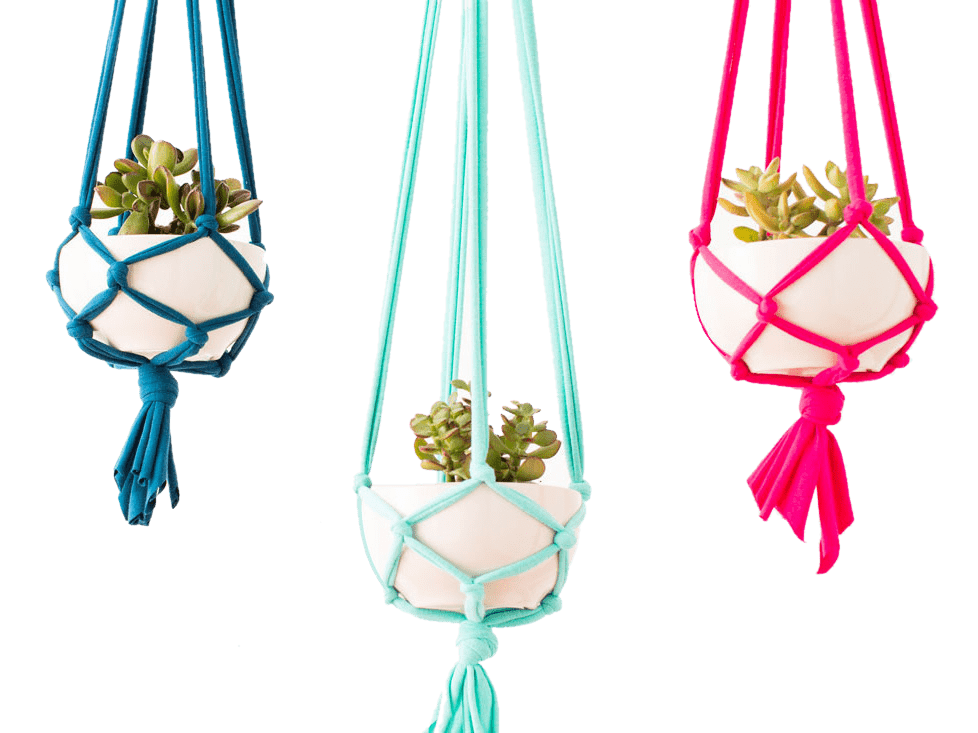
Fence from dishes (photo)
Dishes beat happily. There are three plates left from your favorite set, which are not only ashamed to put on the table, but also insulting to tears. The saucer is cracked or split in half, it doesn't matter, we collect the fragments for the fence, they will serve as an excellent basis for the creative design of the flower bed.
Simply stuck in the ground or embedded in a cement mortar, once works of ceramic art, today will become an original decoration flowering plants... The simplicity, durability and uniqueness of such a fence for flower beds is an undoubted plus, the minuses include only some danger to children, because it can split and injure.
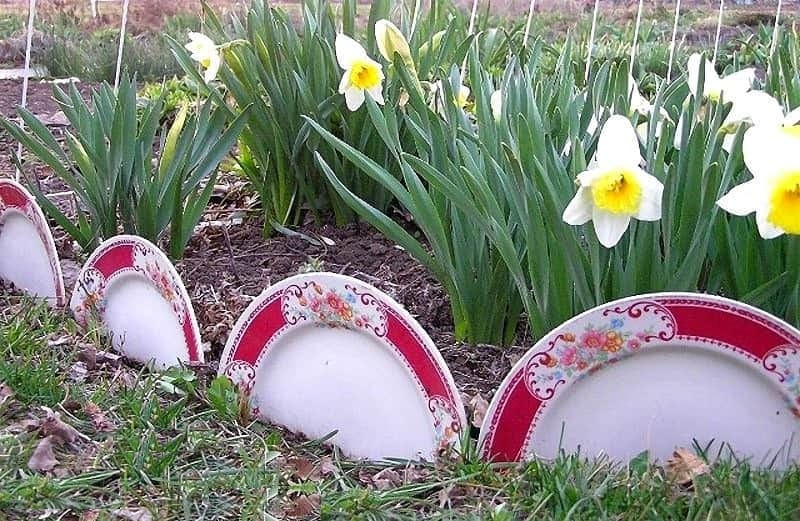
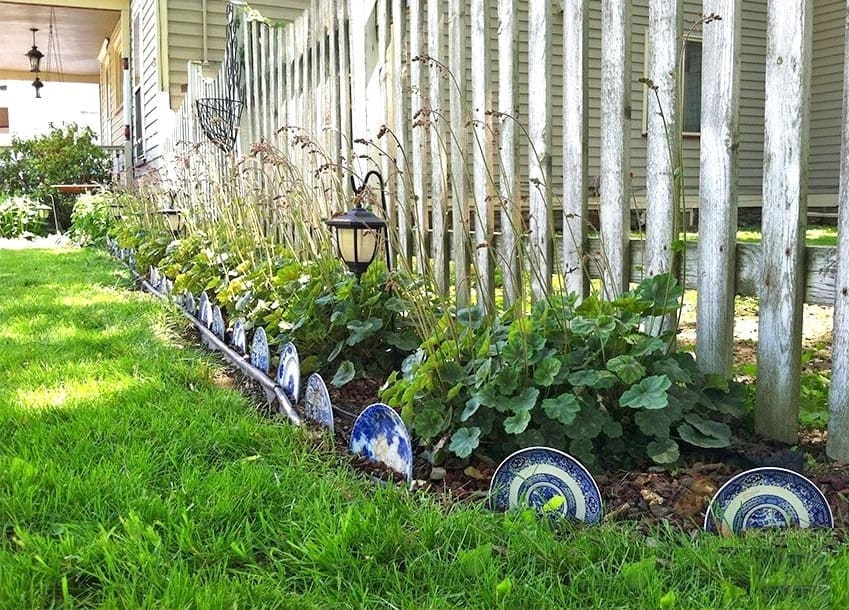
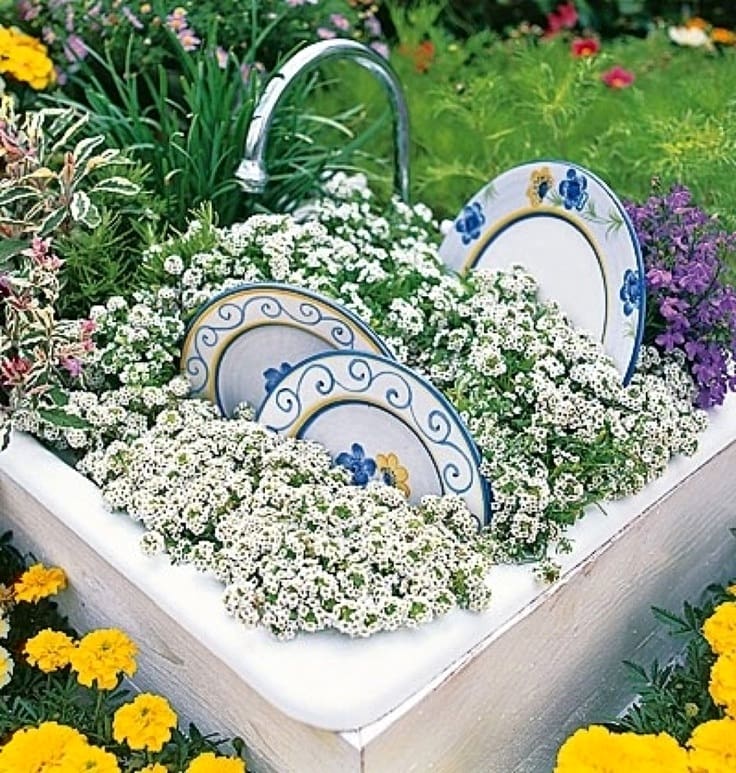
DVDs playable by the sun
Many video and audio lovers often have a large number of unnecessary discs in their home, which have already played their contents millions of times and have lost their freshness and quality. By combining them with a paper clip, wire or fishing line into a single canvas and fixing them on pegs, you can give the flower bed an unusual, bright and shiny, in all respects, look.
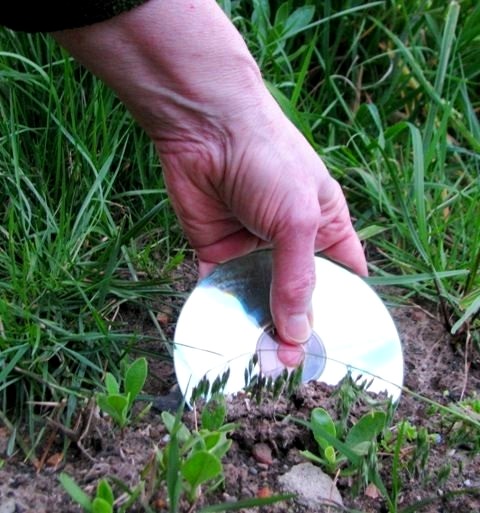
The disadvantage of such an undertaking is only a short service life of this fence. For the rest, it can become an original solution in the landscape design of any site.
Plastic bottles - flight for imagination
The rest after the feasts can also come in handy for a flower bed decorator. Inserted like glass bottles, carefully painted in different colors, illuminate the green space with bright notes.
However, it is worth remembering that plastic is subject to deformation when the temperature changes, therefore, before directly inserting the bottles into the ground, it is worth carefully filling them with sand. Possible deformation, when influenced by weather conditions, is a minus of these fences.
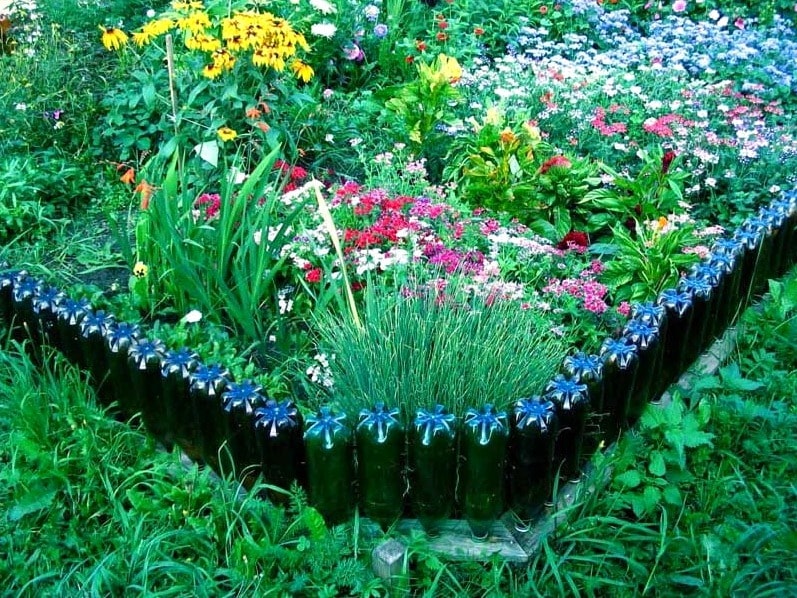
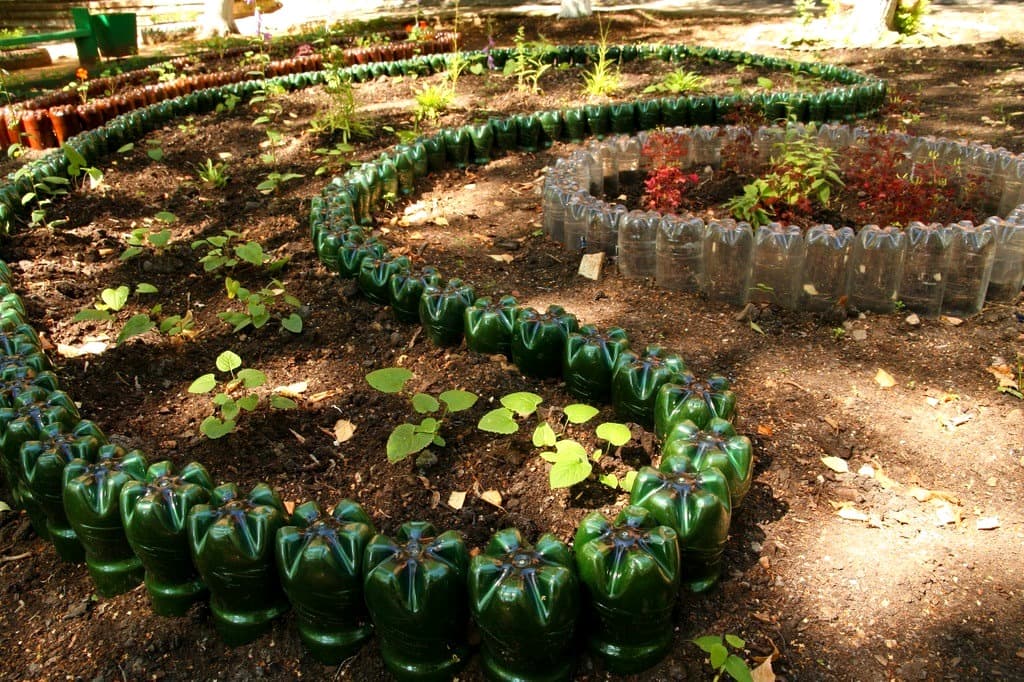
DIY decorative fences for flower beds
Items such as an old fence, remnants of roofing tiles or wall plastic, unused metal tape on a roll, forged items and other scrap materials can be an interesting basis for creating a flower fence.
Their presence, in various configurations, will add a touch of chaos and modern colors to the green ornament of plants, forcing the owners and guests of the summer cottage to look at classic forms from the other side.
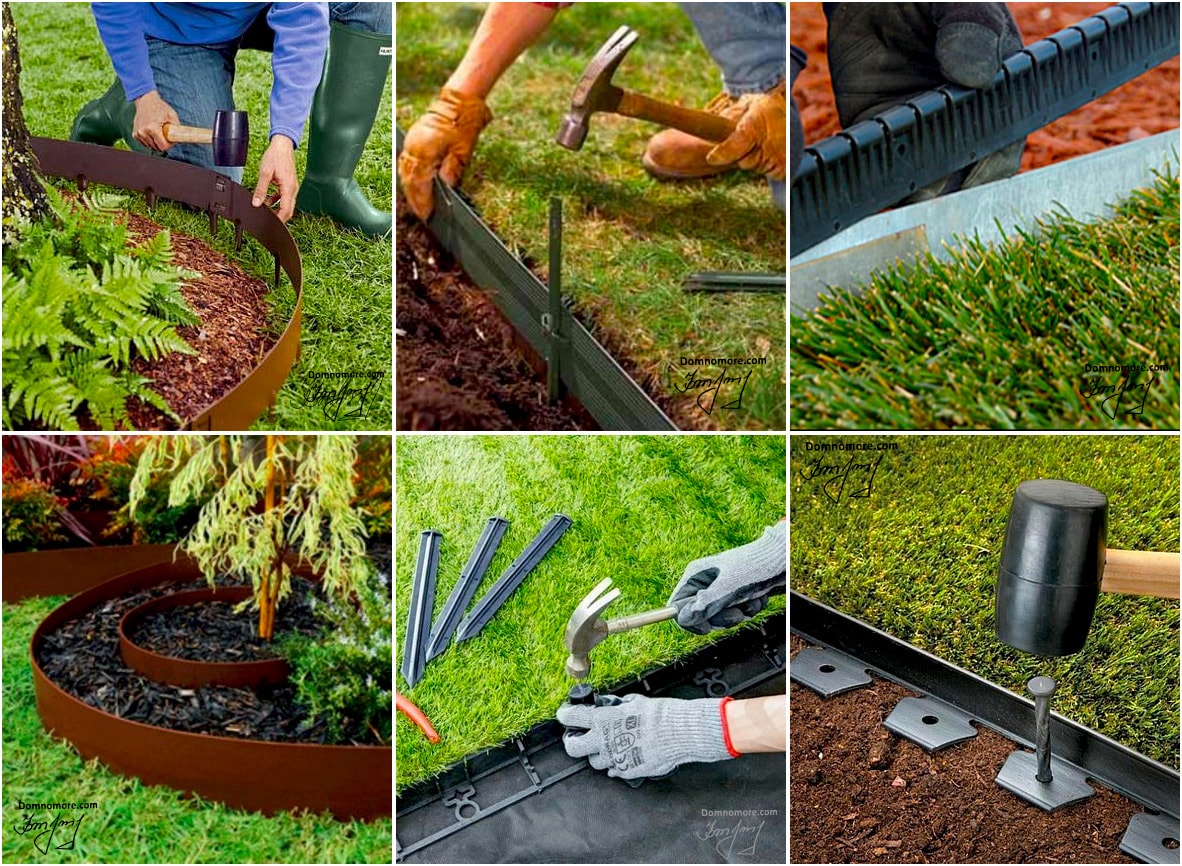
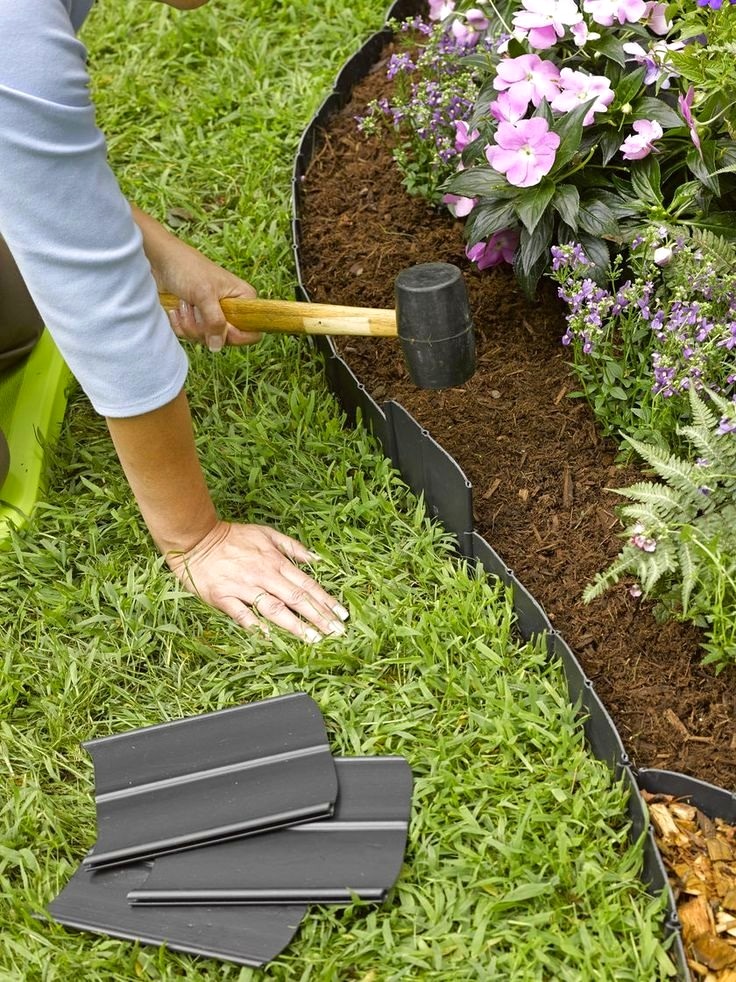
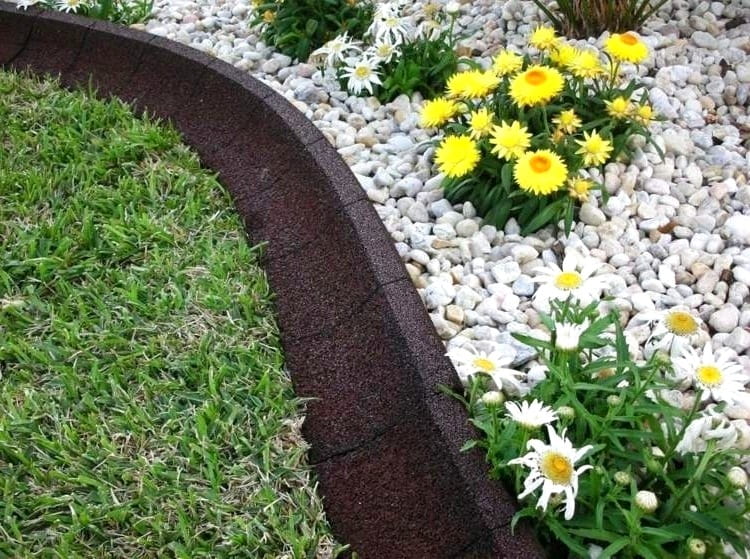
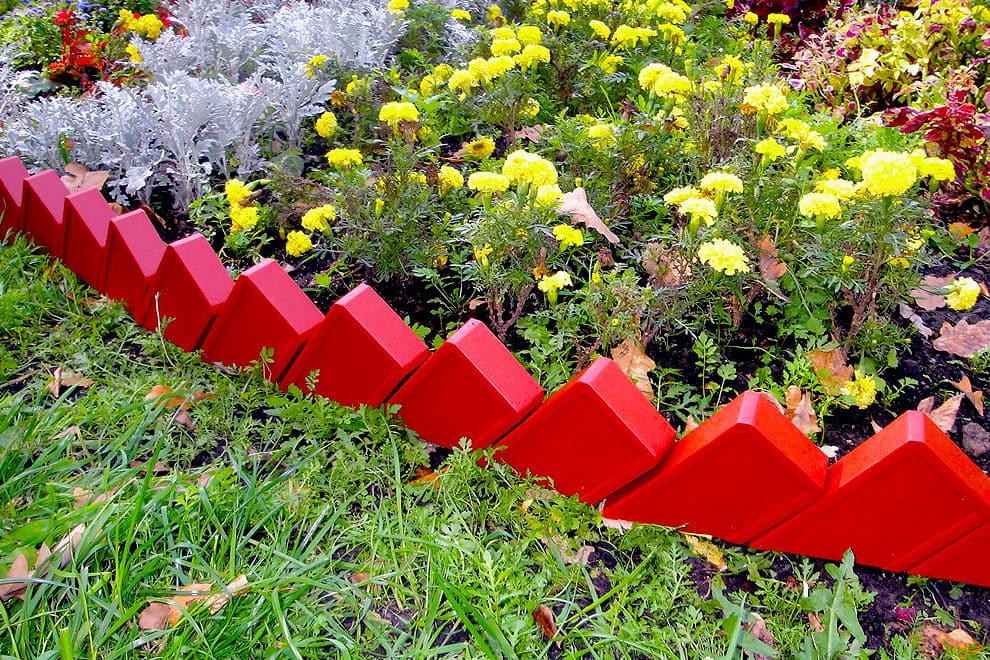
The variety of design options for flower beds, at times, amazes the most experienced florist. Wood, glass, stone chips, knitting, weaving and many other materials reveal countless creative ideas of the owners of summer cottages and simply lovers of aesthetics and beauty.
Consider a few more ideas aimed at fences for flower beds, which use improvised non-standard materials.
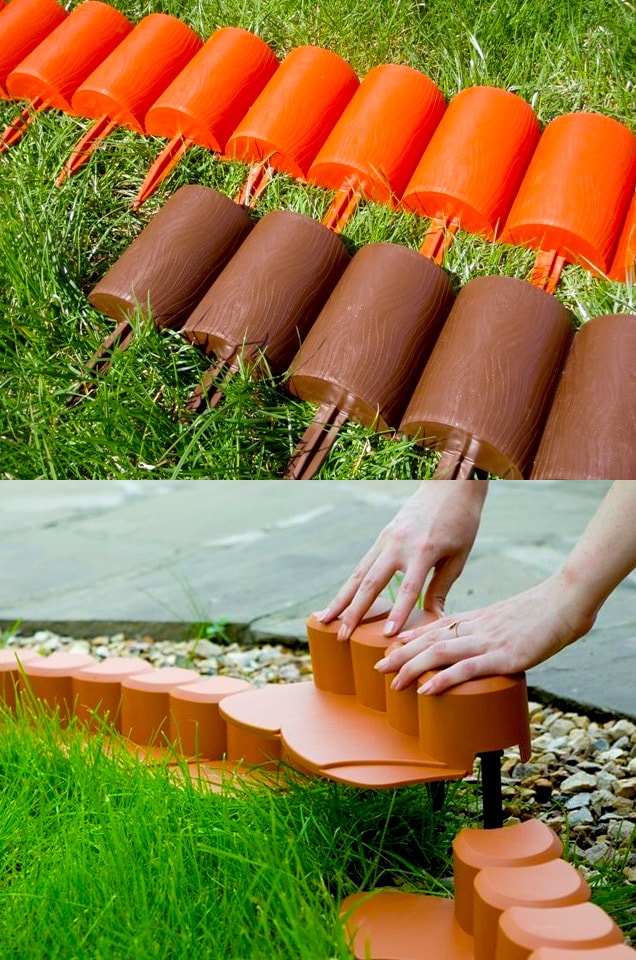
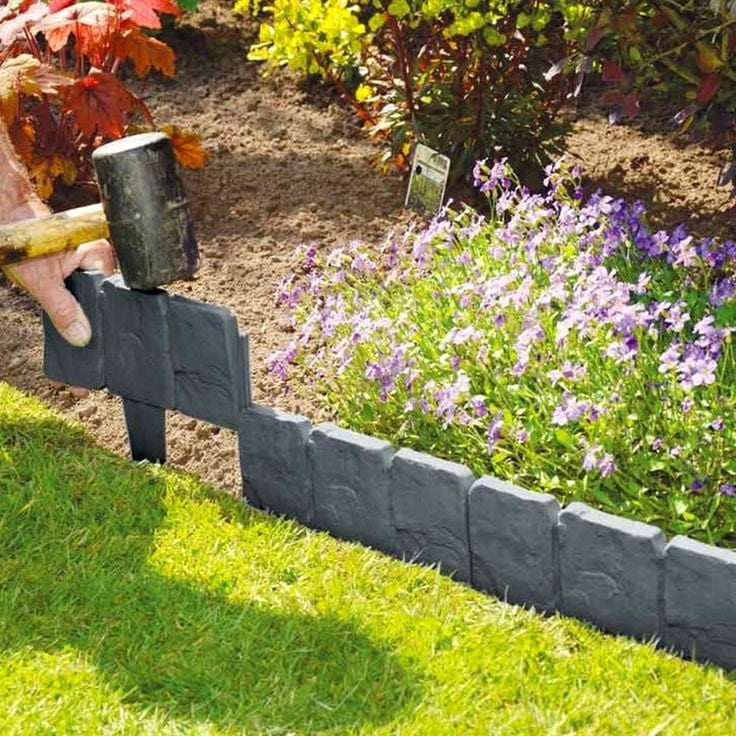
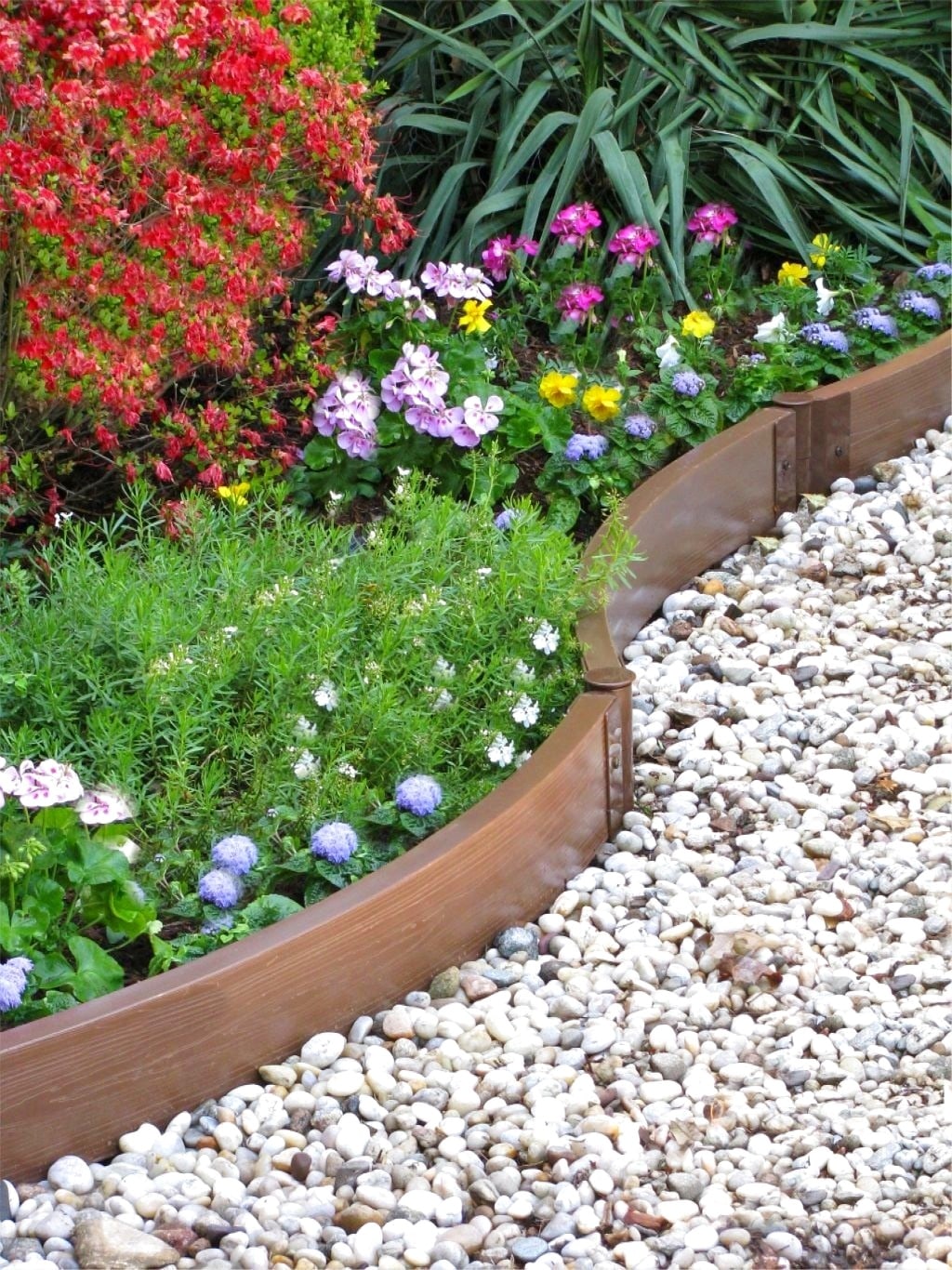
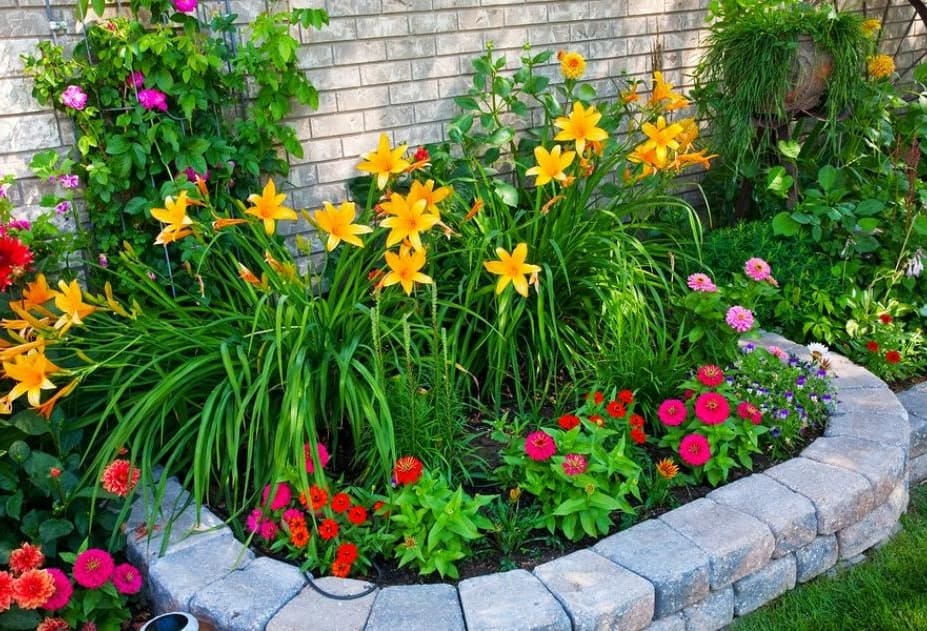
Stone curb - a classic option for fencing a flower bed in the country
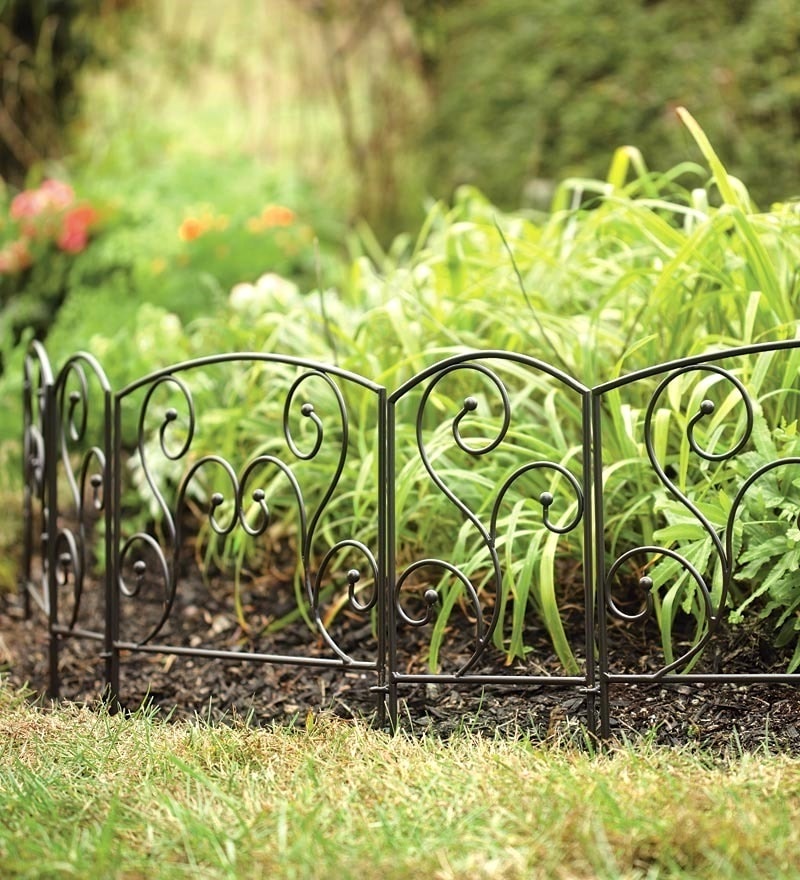
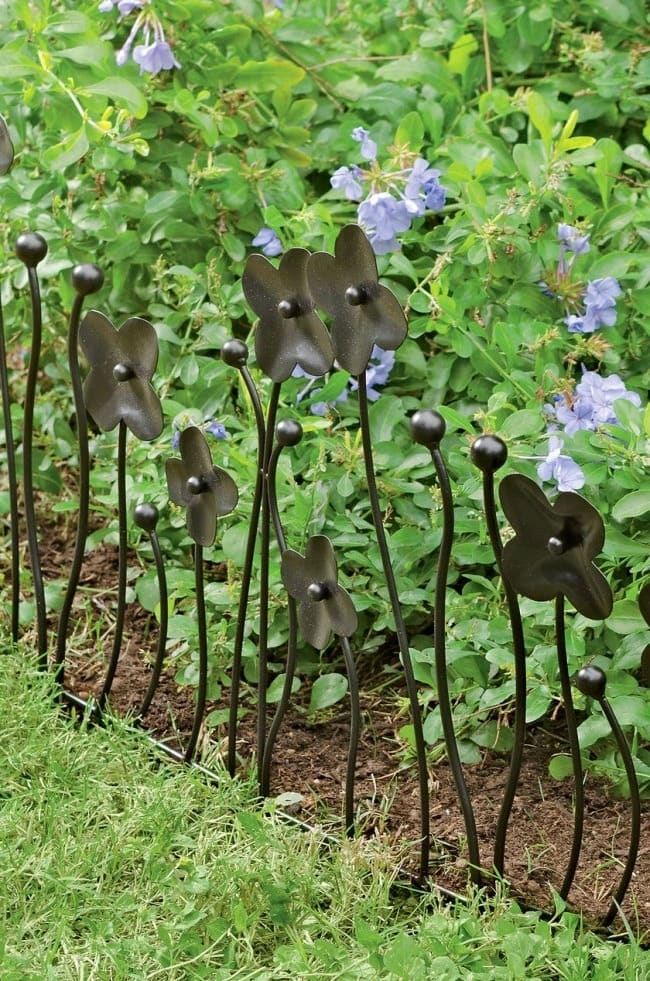
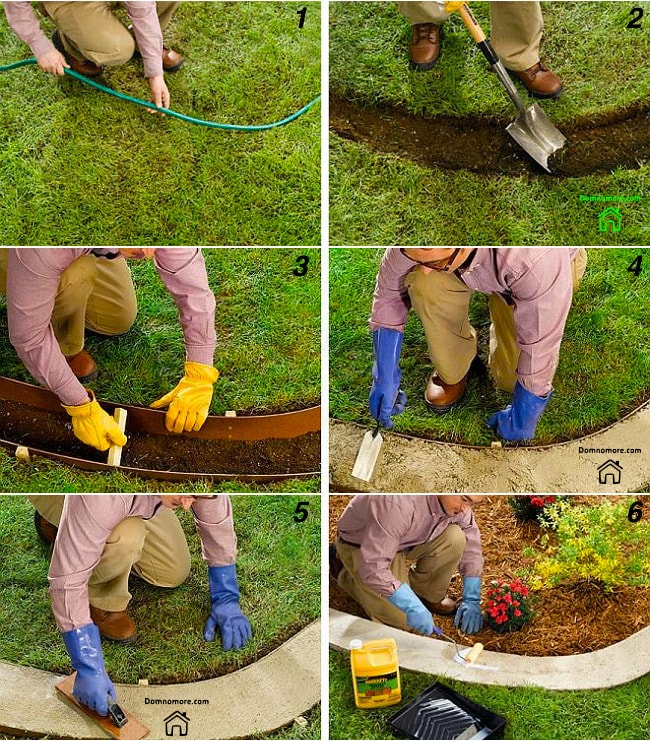

![]()
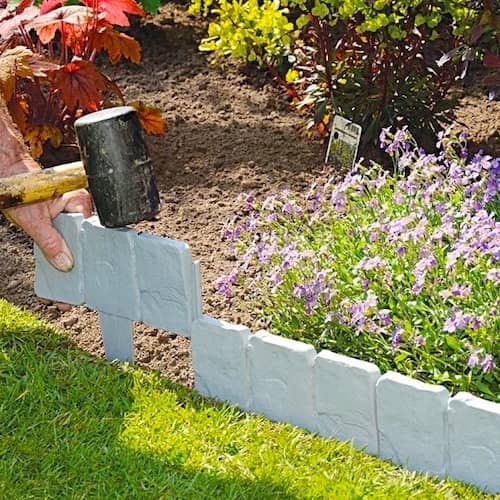
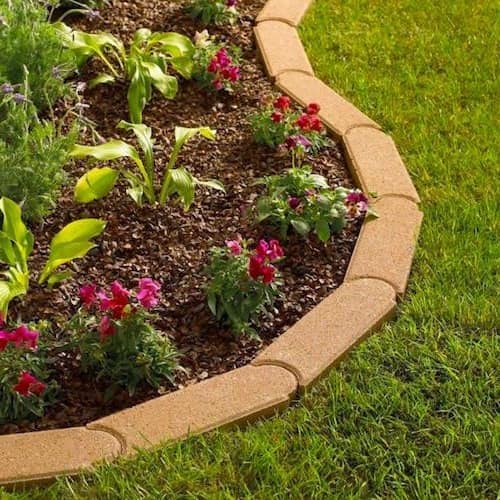
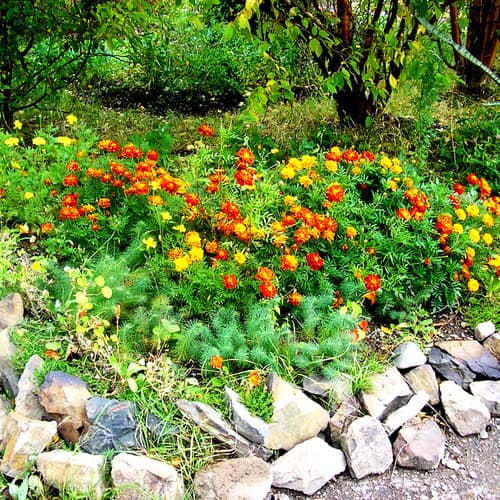
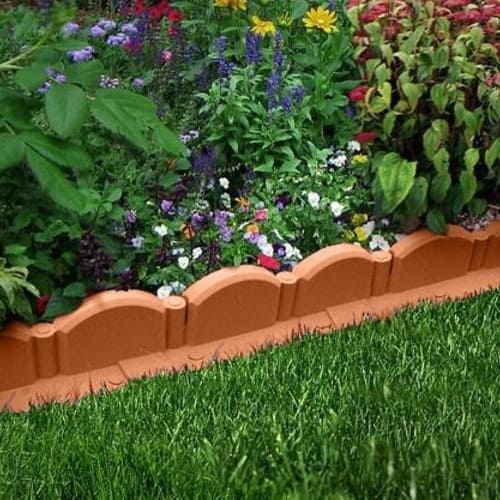
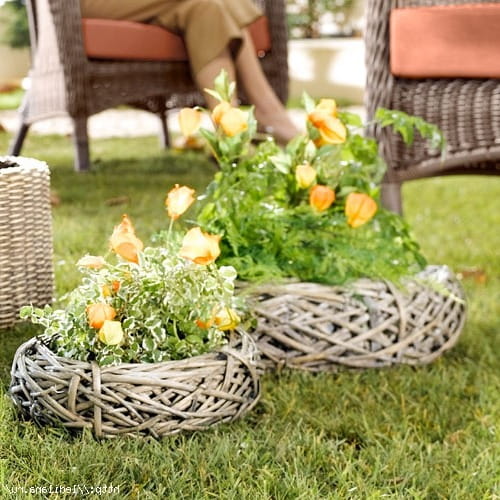

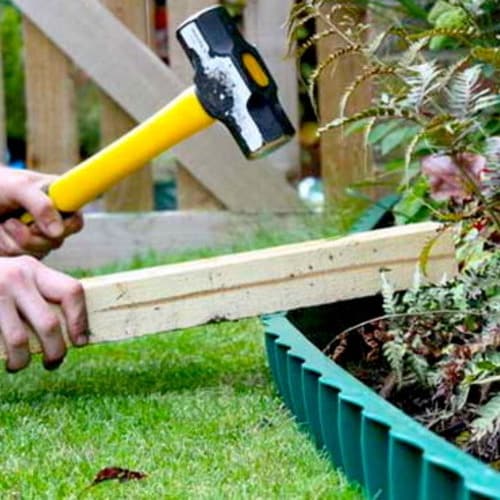
The creation and decoration of flower beds is undoubtedly a fascinating creative activity, and the flight of imagination here is hardly limited to the usual forms and materials.
Creating, against the background of favorite plants, an object of landscape art, each owner will be able to feel like a creator of something new, unusual, original. The main thing is a positive attitude and focus on a truly grandiose result.
In contact with
Sooner or later, but the happy owners of a private house are thinking about arranging a front garden. Wanting to give your home an excellent appearance, saturate the yard with the heady aroma of flowering plants, there is a need to create a front garden, which will be the very special place for these purposes. There are many options for how to make a front garden using the most unpredictable materials. However, metal remains the most durable and reliable.
Metal fence for the front garden from metal elements
What qualities a metal front garden has, and what is needed for its arrangement, we will consider further.
Varieties of metal fences for front gardens
At its core, metal is one of the most versatile materials for the construction of various kinds of fences. It is durable, easy to install and operate, and is also quite accessible to everyone.
There are several options for arranging a front garden made of metal:
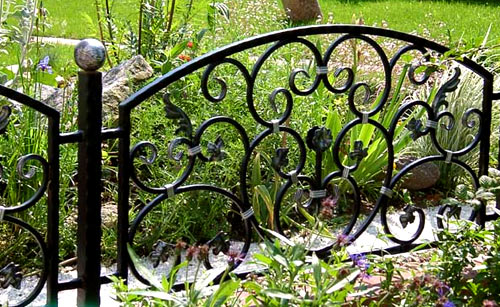
Building a front garden with your own hands is not at all difficult, and it can also be quite an exciting activity, giving free rein to imagination and the ability to make a unique masterpiece that the neighbors will envy.
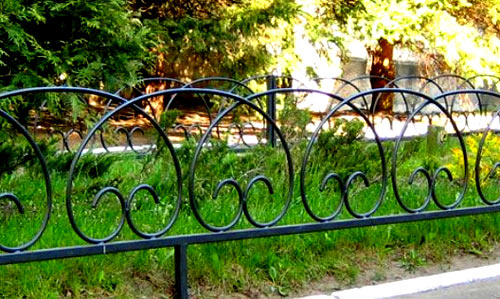
Low lawn fence
Metal front garden: pros and cons of using
A fence or fence made of metal undoubtedly has excellent qualities that make them in demand. Among the advantages of arranging a metal front garden are the following:
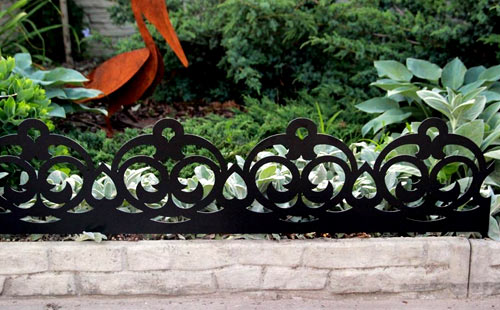
Of the shortcomings, only one should be noted - this is the need to cover the fence with an anti-corrosion agent and its timely painting. Any scratches, frequent precipitation and sudden changes in temperature contribute to the fact that the paint begins to peel over time, making the metal more vulnerable to corrosion.
Mesh front garden fence
Many people in vain underestimate the metal mesh, considering it rather simple fences. Along with its simplicity, such a front garden fence will provide two benefits in one. Firstly, the mesh is quite strong, and when properly installed, it can withstand mechanical stress.
Secondly, by planting climbing plants along such a fence, you can get fences of extraordinary beauty, completely enveloped in green flowering plants. For many people, it will remain a mystery how to make such an amazing fence from plants, and we will consider creating it with our own hands in stages.
Do it yourself
So, wanting to get a solid fence that does not hide all the beauties of the front garden, you will need materials such as:
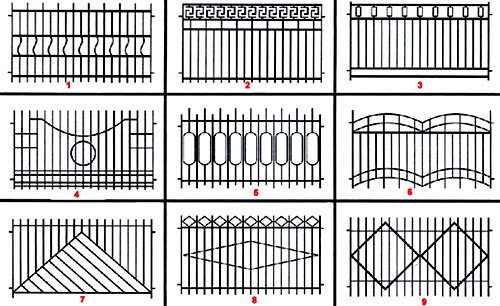
Several schemes and patterns of a metal fence for a front garden
- metal poles or pipes - needed to support and fasten the mesh;
- metal grid;
- scissors for metal;
- welding.
Step 1 - Project creation and procurement of materials
Before starting work, you need to purchase materials, and their quantity can only be found from the corresponding measurements. It is necessary to determine the parameters of the front garden and outline the boundaries of the future fence.
When all the necessary measurements have been made and the amount of the required material has been calculated, you can go to the store to purchase everything you need. When choosing a mesh, you need to pay special attention to its quality, as well as the diameter of the holes. If you want to get a strong support, you should focus on small but frequent holes.

An example of a fence for a front garden from corners and a chain-link mesh
Fences installed for aesthetic purposes can have large openings that let light and heat into the front garden unhindered.
If the fence is not high, then the support pillars can be taken the simplest, or replaced with metal pipes.
Step 2 - Installation
The first thing to do is to install the support posts. They are installed at a distance of 2-3 meters between themselves. In order for the supports to be stable and not heel under the influence of various external factors, it is necessary to ground them to a depth of 1-2 meters.
When all the pillars are installed, proceed to the most difficult thing - fastening the mesh. To do this, the mesh is welded at one edge by welding, then pulled to the other pillar and each subsequent section is fixed in the same way.
If the front garden assumes a wicket, then for its arrangement a frame welded from a profile and covered with the same mesh is needed. A wicket is installed on awnings, which are attached to the support pillars.
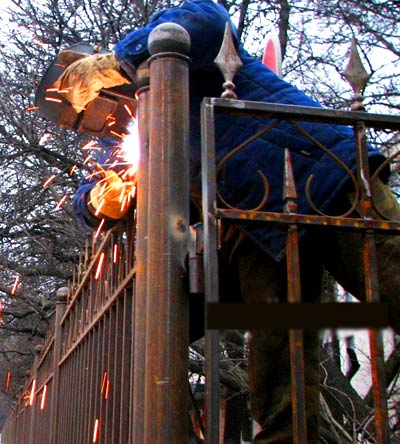
The process of welding a section of a fence with a support post
If the fence of the front garden is high, then it is necessary to place auxiliary logs between the support posts, which will keep the mesh in its original position and prevent it from sagging in strong winds.
In the old days, almost every rural house could see a front garden drowning in flowers. For a while, even the villagers forgot about the front gardens. Wealthy citizens were carried away by the novelties of landscape design, which came from abroad. And today, to the delight of the owners of private estates, the fashion for cozy beautiful flower beds in front of the house is returning. To equip the area near the house, it must be fenced off. The fence for the front garden is sold already in a ready-made sectional form. But for yourself, you can make a fence with your own hands.
Fence for front garden made of euro picket fence
Varieties of fences for front gardens
The whole point of arranging a front garden is to create clear boundaries for the flower garden. A fence works best with this task. Made of metal, wood, plastic, stone or any material at hand, it should organically fit into the overall picture of home ownership. Before making a fence for the front garden with your own hands, you need to determine a few points for yourself:
- Future fence design
- Its shape and height
- The color of the entire structure
- The material from which it will be made
The last point needs to be given special attention, since the fence should not distract attention from the beauty of the flower garden, but should fully fulfill all its functions.
There are a lot of varieties of fences for front gardens. In its manufacture, you can focus on the options that the construction market offers. But many people prefer to rely on their taste, imagination and skills in working with different materials.
You can make a fence for the front garden from wood, metal, brick, concrete, plastic, or make a combined fence. Let's consider the most popular options.
Wooden fences
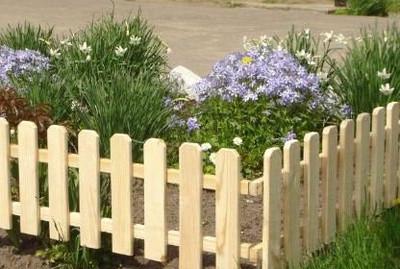 Wooden fence for the front garden
Wooden fence for the front garden Despite the huge range of modern materials, wood never goes out of style. Wooden fences are not among the cheapest options. However, this material is always available and environmentally friendly. You can make a lot of it different options fences. The simplest of them, which you can completely do yourself or mount purchased sections:
- Fence. A ready-made fence of the required height can be purchased at the store. And for its installation, the installation of support pillars will be required. Outwardly, such a fence is a collection of identical planks attached to two profiles. A distance of several centimeters is left between the plates. Through such a fence, sunlight penetrates into the front garden well, and the entire flower garden is perfectly visible. If you have the skills in woodworking and the necessary set of tools, then the picket fence can be completely made independently, or you can make a template and order from the master. The height and width of the pickets are selected individually.
- Wicker fences. You can find a lot of information on the Internet about how to make a fence for a patio or a small front garden from willow vines. To make a wicker fence, it will take a lot of time to prepare the material and the weaving process. But the result is worth it. For supports, you need to pick up branches, preferably oak, with a diameter of at least 5 centimeters. In the marked area, they are installed at a distance of 25-50 centimeters from each other and braided with a vine in a checkerboard pattern. The vine must be steamed before starting work for better flexibility. As they dry in the finished fence, they will acquire the necessary rigidity.
- Bar. The fence is made from cuts of boards, which are attached horizontally to the support posts. Such fences are needed where the flower garden requires protection from outside influences.
In general, wooden fences are made of different designs:
- with vertical, horizontal or diagonal arrangement of boards
- in the form of a continuous web
- with holes between the individual elements
The design of a wooden fence is chosen taking into account the following features:
- terrain
- architectural style of buildings
- their financial capabilities and skills
For the manufacture of wooden fences, it is important to choose the right material. The wood must be dry and free from visible insect damage. To extend the life of the finished structure, it should be treated with special antifungal drugs.
Metal fences
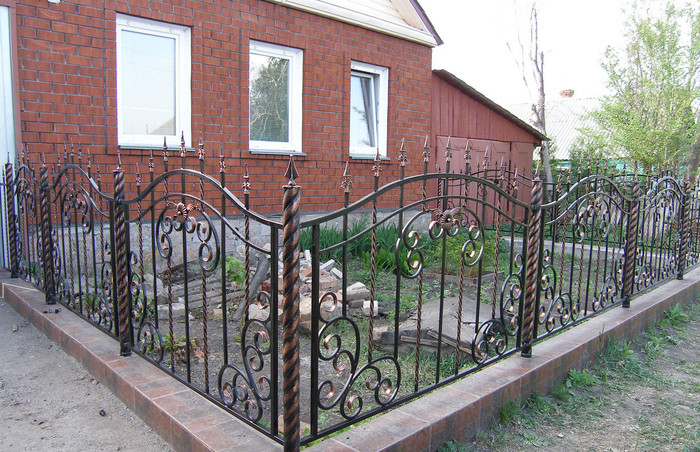 Forged elements front garden fence
Forged elements front garden fence Metal fences for front gardens will last a long time, as they are particularly durable and reliable.
- Forged designs from a flower garden can make a real work of art. Craftsmen can create a wrought-iron fence of great beauty, decorating it with curls, simple patterns or floral designs. In order to mount such a fence, the strength of several people is required. The heavy weight of the structure also requires the arrangement of the foundation.
- The metal grate serves not only as a fence for the front garden. It can be an ideal base for climbing plants.
- A metal picket fence looks the same as a wooden one. But the installation process, quality characteristics and service life are significantly different from wooden counterparts.
Any metal fence will last a long time proper care... Metal requires anti-corrosion treatment and as required.
Chain-link fence
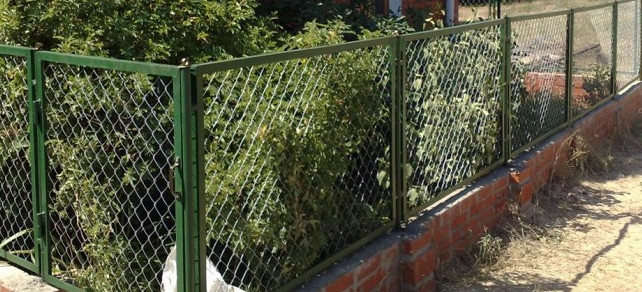 Front garden fence made of chain-link mesh
Front garden fence made of chain-link mesh Ease of installation, variety, availability, affordable cost are the factors that make the netting one of the most popular materials for arranging front gardens. To some, this option may seem too simple. However, a chain-link fence can be made simply luxurious by planting climbing flowering plants next to it.
Installation of such a fence will require the installation of support pillars. If the netting is metal, then the posts must be metal so that they can cope with the high load from the weight of the net.
It is better to pull the mesh, especially metal, over the frame so that it does not sag during operation. This requires a welding machine.
Plastic fence for front garden (PVC)
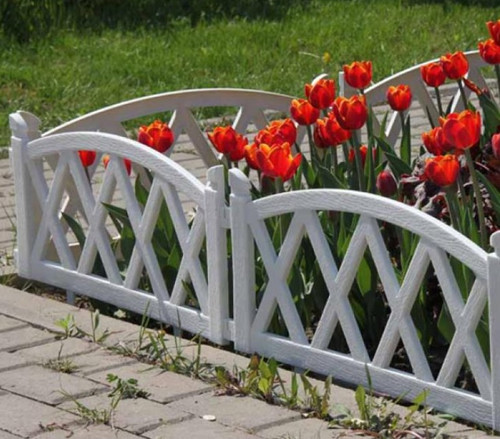 Fence made of PVC plastic
Fence made of PVC plastic Plastic fences have recently begun to be used in gardening culture. There are excellent options available from the store. But if you include imagination, then you can give a second life to any improvised material: plastic bottles, pipe scraps, pieces of plastic sheets, etc. On the sites where the most creative homemade ideas are posted, there are many interesting options to bring to life.
Stone fence
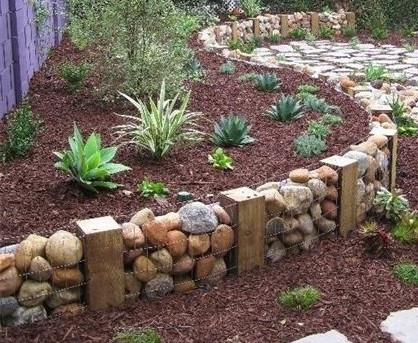 Stone fence
Stone fence Stone is a durable and reliable natural material. As a rule, it is used in regions where it just lies underfoot. Why not use this unique material that you don't even need to buy? The stone does not need additional processing, since it is not subject to mechanical and weather influences. Artistic masonry will make your fence truly unique.
For the arrangement of front gardens, the following types of natural stone are most often used: sandstone, slate, granite, tuff. A large number of shapes, sizes, edges of raw material greatly facilitate the construction process.
Concrete structures
Concrete structures are distinguished not only by strength and reliability, but also by a variety of shapes. They can be made in the form of a solid wall or an elegant decorative fence. Since concrete can take almost any shape, manufacturers make full use of this feature by making fences that imitate other materials: stone, picket fence, slate, brick, plastic, etc.
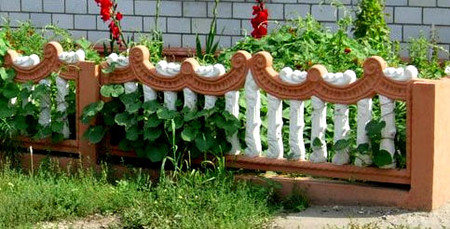 Concrete front garden fence
Concrete front garden fence The disadvantages of such structures include high weight. To equip the fence in the front garden, you will have to make a base in the form of a foundation. It will also not work to mount the fence alone.
Fence base
Any fence for the front garden is attached to the support posts during installation. A gap is left from the bottom of the fence to the ground. Pets can easily enter the flower garden through this gap, and the uneven relief spoils the appearance of the front garden. In addition, heavy structures place a high load on the supports. It is for these reasons that most often foundations are made for fences in the form of foundations. Foundation options, height and width, appearance are determined based on the following parameters:
- soil type
- the height and width of the future fencing
- the degree of mechanical loading of the fence
- A few tips for arranging a front garden
Landscaping experts advise:
- Make a front garden from scratch
- At the planning stage, decide on the function and appearance of the fence
- The fence should not be deaf and too high
- Fence staining should take place before planting
- The shape, color and material of the fence should be in harmony with the overall design of the site
- Fences more than 80 centimeters high are complemented with a wicket
- If you do not have certain skills, it is better to buy ready-made sections for the future fence, which are easier to assemble yourself
The choice of a fence for your front garden must be approached responsibly and thoroughly. After all, he plays an important role in shaping the design of the entire site. Patience, work and imagination will help make a magnificent fence even from the simplest material.
It is no secret that a wrought iron fence or front garden can be called one of the most sophisticated and stylish types of fencing in a country house. Having a respectable appearance, it is able not only to become a decoration of the territory of private houses, but also to reliably protect the property of the owners from the intrusion of unauthorized persons.
The only drawback of hammered metal structures is their rather high price, which is quite reasonable. Indeed, as a result of the work of a whole team of specialists, including engineers, designers, architects and blacksmiths, an exclusive work is obtained that has no analogues in grace and beauty.
Combination of building style with a wrought iron fence
![]()
Despite the fact that forged fences or cast-iron parts for decorating the front garden bring their zest to the interior of the house, they do not fit into every facade design. According to experts in the field of landscape and architecture, chased details are especially successfully combined with large-scale cottages, made in austere antique style. In addition, metal gratings can be used for fencing private houses made of timber or decorated with wooden elements.
If the house is built in an ultra-modern style, fragments of hammered metal can also be used in the design of a fence or front garden. The only thing, in order to achieve complete harmony of classic and modern style, is to repeat the same simple pattern in various elements of the overall design: a lantern over the front door of the house, a bench, a gazebo.
Advantages of forged fencing structures
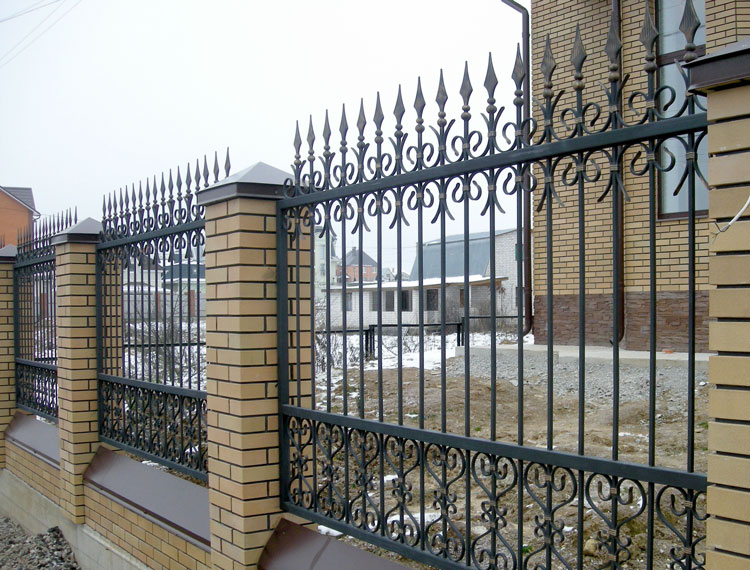
Forged fences for a house, compared to stone, concrete or wood, have a number of undeniable advantages:
1. Reliability and durability.
Forged metal is known to be extremely durable. And constructions made from it can last for many years and endure any unpleasant weather conditions. Such wrought-iron fences are not afraid mechanical stress, the resistant metal can survive even in a collision with a car.
2. Home safety.
The first requirement for fences is to ensure the safety of the home, and chased fences do an excellent job with this task. It is unlikely that there are many who want to overcome the high wrought-iron fence, ending with iron peaks. In addition, it is quite appropriate to assume that there is a security guard or a video camera behind the fence or front garden. To hide the territory of your house from prying eyes, you can build a fence with polycarbonate.
3. Easy to maintain.
A huge advantage of forged fences is the ease of maintenance. Such a fence of private houses does not have to be cleaned and tinted every year, repaired and covered with moisture protection. And if during operation there are small defects, there are simple ways their elimination on the spot.
4. Appearance.
The huge variety in the design of forged fences and lattices allows you to choose the only option that will fully fit into the interior and help create an elegant, rich image of the estate.
Possessing all the advantages listed above, a fence forged from metal will undoubtedly become the hallmark of a private house.
Types of forged structures
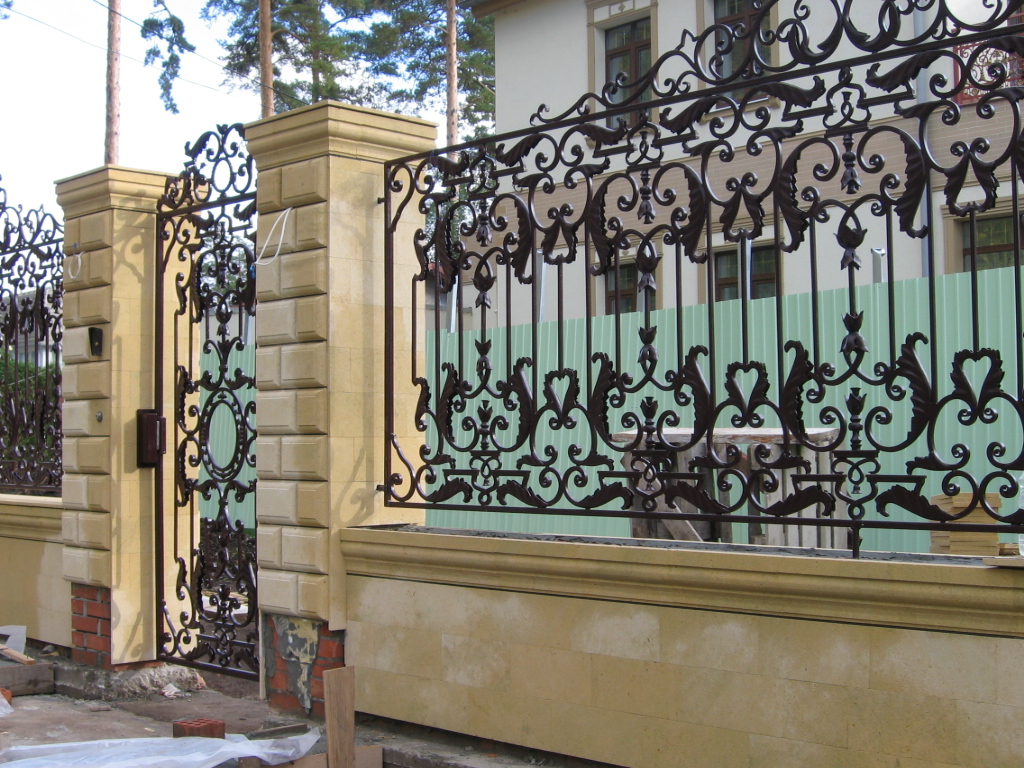
Forged metal fences are divided into several types by their structure.
Protective fences are the easiest to implement and inexpensive in cost. They are fences made of solid sections, connected by welding. A beautiful metal decor is attached to the spans with the help of special screw connections. Such fences and front gardens are durable and beautiful, and besides, they are easy and quick to assemble.
The decorative wrought iron fence is distinguished by its attractive appearance. Usually it is made by craftsmen according to individual drawings. In addition, when creating a decorative embossed fence or front garden, special connections of elements are used with clamps and tabs. Welding and stamps are used only in cases specified by the client. Such beautiful wrought iron fences, which are the result of painstaking work of the artist, have a higher cost in relation to other types of fences.
Combined fence with forging is the middle between the first two types. During their manufacture, clamps and rivets, electric and forging soldering, twisting and bending are used. Combined forged fence combines the aesthetics of beautiful fences and the reliability of protective structures.
Manufacturing technology
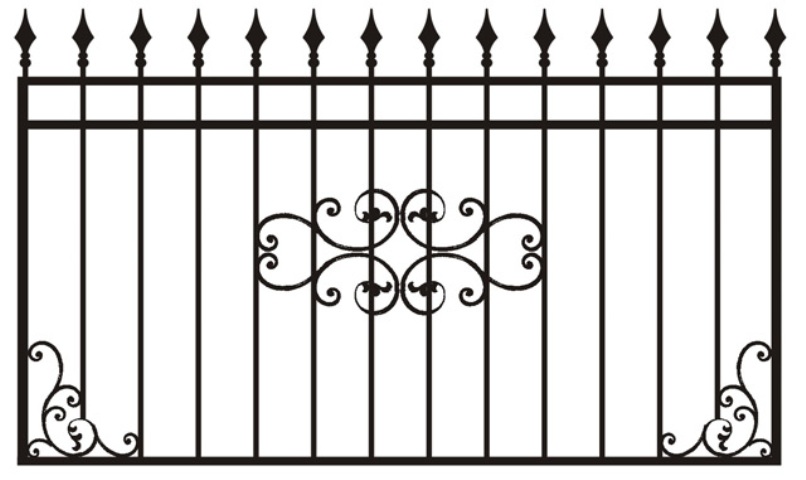
There are several ways to make forged fences and front gardens. The simplest and most inexpensive of them is to weld metal structures according to the drawings.
Real forging differs from other methods in that all work is done by hand. This option for making a fence is not the most common, as it is laborious and time-consuming. The production and fastening of the elements to each other takes place with a hammer.
The most popular and affordable option for making beautiful chased fences is the forged-welded method. In this case, ready-made elements, for example, strips and rods, according to the drawings, are combined into a structure in various simple ways.
Any of the methods by which forged fences and front gardens are made requires from the masters non-standard design ideas and the ability to do their job with high quality.
Criteria for choosing a forged fence
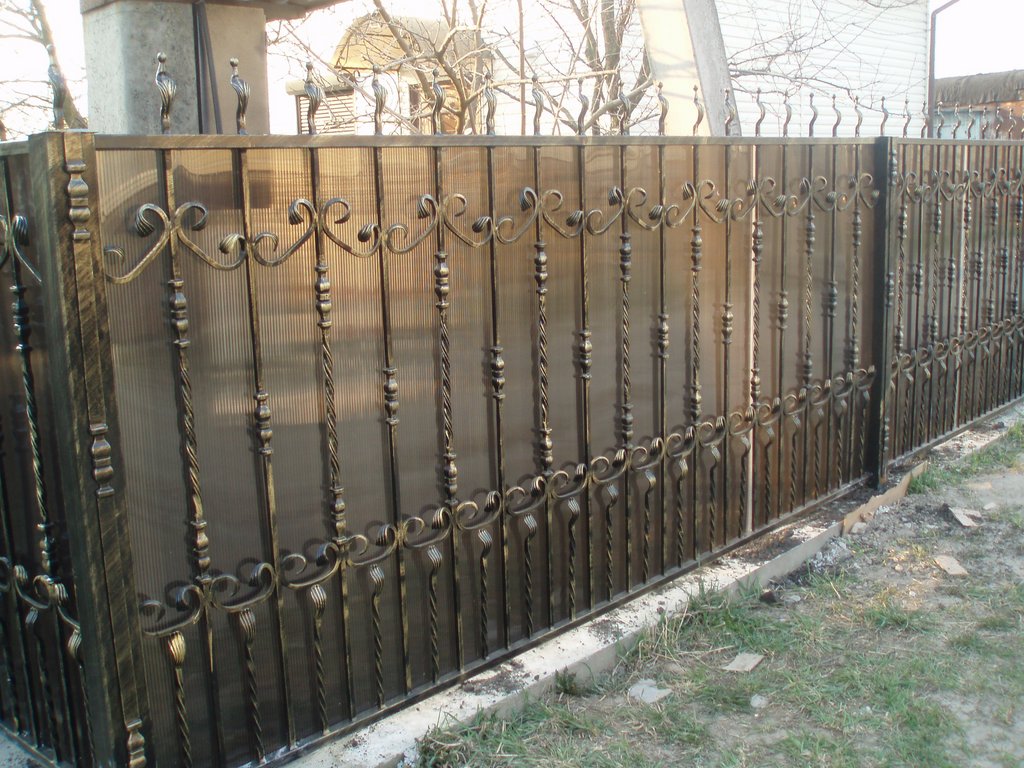
Fence with forging elements decorated with polycarbonate for less viewing
Various materials can be used for the production of decorative wrought iron gratings and front gardens, namely cast iron, iron, steel, ferroalloys. With the right choice of material, a forged fence can last more than a dozen years without damage.
It should be borne in mind that usually only cast elements are made of cast iron, and not the grate itself. Therefore, offers to make a beautiful cast-iron fence for a low price are often unreasonable. Sometimes, materials such as titanium, copper, aluminum are used to decorate the spans of the lattice with thin details, which significantly increases the cost of the fence.
To make the forged fence more durable, you can increase the number of decorative elements in the spans. The most acceptable fence height is two meters.
Since the drawings of the pattern for the future fence are developed in a volumetric format, when choosing a fence, you should evaluate its appearance from all sides, and not just from the face. It is best not to try to develop your new drawing that has not been tested in practice, but to heed the advice of professionals. This will save you time and money.
If the new forged fence seems too transparent, polycarbonate plates can be added as protection from prying eyes.
How to paint the grille correctly
To extend the life of a wrought-iron fence or front garden fence and to prevent metal corrosion, the grille should sometimes be painted. For this you need to stock up by the following means and tools:
- metal brush;
- sanding paper;
- brush;
- anti-corrosion primer;
- solvent;
- acrylic paint.
First of all, it is recommended to clean the structure of rust by cleaning it with a hard brush and sanding the metal with paper. Then you should degrease the surface of the parts to be painted and apply a primer, especially carefully treating the joints of several gratings.
After the applied layer has dried, the fence must be painted. For this it is worth using paints used in blacksmithing. Usually, to paint a metal fence for a house, they choose black, gray, dark brown, burgundy tone.
Thus, it can be seen that forged fences have a huge number of different advantages, and if you have the necessary funds, it will be easy to make a choice in favor of fences of this type. It remains only to determine the most suitable type of fencing for yourself and attract craftsmen who are able to bring ideas to life.
A front garden made of wood is one of the most versatile options for arranging a flower garden, in which all work can be done with your own hands, without much physical and financial costs. A wooden fence is very easy to use, it will last for more than a dozen years, if it is properly monitored and redecorated in a timely manner.
Decoration and arrangement of a front garden and a wooden fence
Variations of wooden fences for the front garden, as well as how to make a fence with your own hands, we will consider further.
Benefits of wooden fences
It is no secret that wood with excellent qualities has been used in construction for a long time. With the advent of plastic and other analogs into the world of building materials, interest in wood has not disappeared, since the naturalness of raw materials is always appreciated above any extended service life.
For a front garden, a low fence is usually chosen, the main purpose of which is to delimit the territory and protect plants from the possible negative impact of environmental factors.
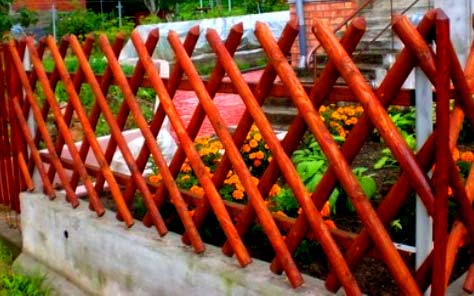
The device of a small fence made of logs
The main purpose of such a fence still remains to give aesthetic completeness to the front garden, as well as to create a harmonious image of the site. Basically wooden front gardens made according to the principle when planks of the same parameters are stuffed perpendicularly onto two parallel guides. This is the most convenient way to work with wood, since solid wooden fence will not stand for a long time, and will not possess the qualities that a picket fence has.
In addition to the picket fence, decorative wood carvings are often used, when individual elements of the fence are attached in a graphic sequence, the end result is a beautiful mosaic decorative fence.
For arranging the front garden, you can also use any lumber that can be attached individually, directly into the ground.
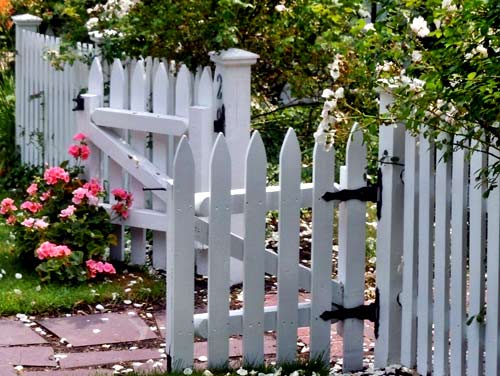
Design of a picket fence for a front garden
No less beautiful and in demand is a wicker fence made of vines, when dried twigs of a tree are intertwined through the supporting pillars, forming a hedge.
Picket fence
A picket fence is a kind of wooden planks attached to two slats. The main feature of this type of fencing is simplicity and ease of installation. All components are attached with nails. Also, such a fence is easily transportable, small-sized and easily lifted without special accessories. Therefore, it can be easily delivered and assembled by hand.
They make boards for a picket fence by cutting a wooden beam into smaller strips with a peculiar shape and size. Typically, woodworking factories are engaged in the manufacture of fences, which, to order, can make the most simple planks for a picket fence.

Picket fence option for the front garden
If desired, and the availability of wood and a machine, you can make a picket fence with your own hands, but this will require additional time effort, as well as the availability of skills in working with wood.
The picket fence used to decorate front gardens can be of two types:
- horizontal - boards are attached horizontally between the support posts, allowing small gaps and gaps;
- vertical - identical planks are attached vertically relative to the horizontal retaining lags.
A wooden fence can also be hammered together from what is at hand. The main thing is that it looks aesthetically pleasing, as well as fencing the line of completion of the front garden.
How to make a wooden fence with your own hands
Making a small fence for the front garden with your own hands will not be difficult even for the most inexperienced carpenters. Let's consider the whole process from and to, highlighting the main points.
Creating a drawing, calculating the amount of required material
At this stage, you need to imagine in your thoughts everything to the nuances, what kind of front garden will be, where it will be located, and also what its main role will be. After that, it is advisable to mark the future fence on the ground in order to make sure that your own thoughts are correct. Measurements are taken according to the markings; for these purposes, you can use a construction tape.
All digital values \u200b\u200bmust be fixed on the drawing of the fence, since they will be used to further calculate the amount of material required for building a front garden fence with your own hands. When there is data on the dimensions of the future fencing, you need to calculate how many materials will be needed.
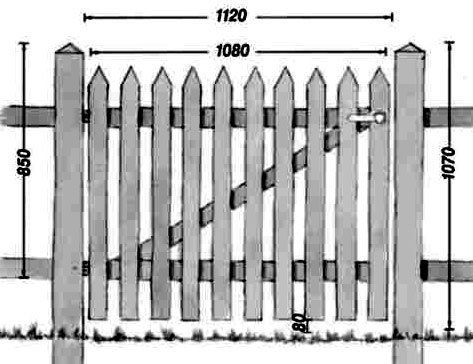
Drawing with the dimensions of the picket fence for the front garden
The guide logs are the easiest to calculate: their footage depends on the length of the front garden perimeter. But it is worth remembering that the lag is necessarily two (bottom and top), so we multiply the required footage by two. The number of planks is a little more difficult to calculate, but on the Internet there are a lot of construction calculators that help, knowing the length of the fence, calculate the required number of planks, taking into account the required distance between them. If it is not possible to use such computers, you can remember the math lessons at school and calculate everything yourself.
So, knowing the length of the fence, you need to decide how wide one plank will be. If this parameter is set by the manufacturer, then the total length must be divided by the width of one plank, not forgetting about the error (10% or optional), which is set aside for the distance between them.
Material preparation
If you plan to buy a picket fence, then the only difficulty is its delivery, which, in principle, cannot be called a difficulty.
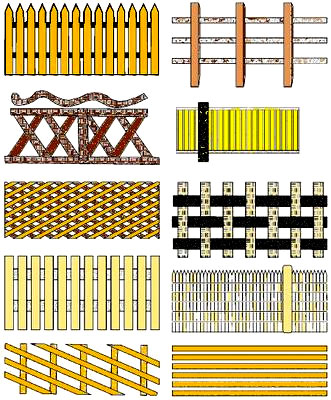
Several options for decorating a fence for a front garden
It folds easily and is perfectly transported over any distance, the main condition for maintaining its integrity is the absence of unwanted excess moisture in the car.
When all the components of the picket fence are made by hand, then you need to remember that the more accurate the dimensions of all the boards are, the more beautiful the fence will turn out. Having at your disposal a sawmill, you can make such planks that will not only be reliable, but also attractive in appearance.
The pointed or carved tops of the picket fence require extra effort and manual processing, however, the beauty that is obtained in the end is worthy of innumerable praises.
